Bosch HES242U, HES442U, HES245U, HES255U, HES246U Manual
...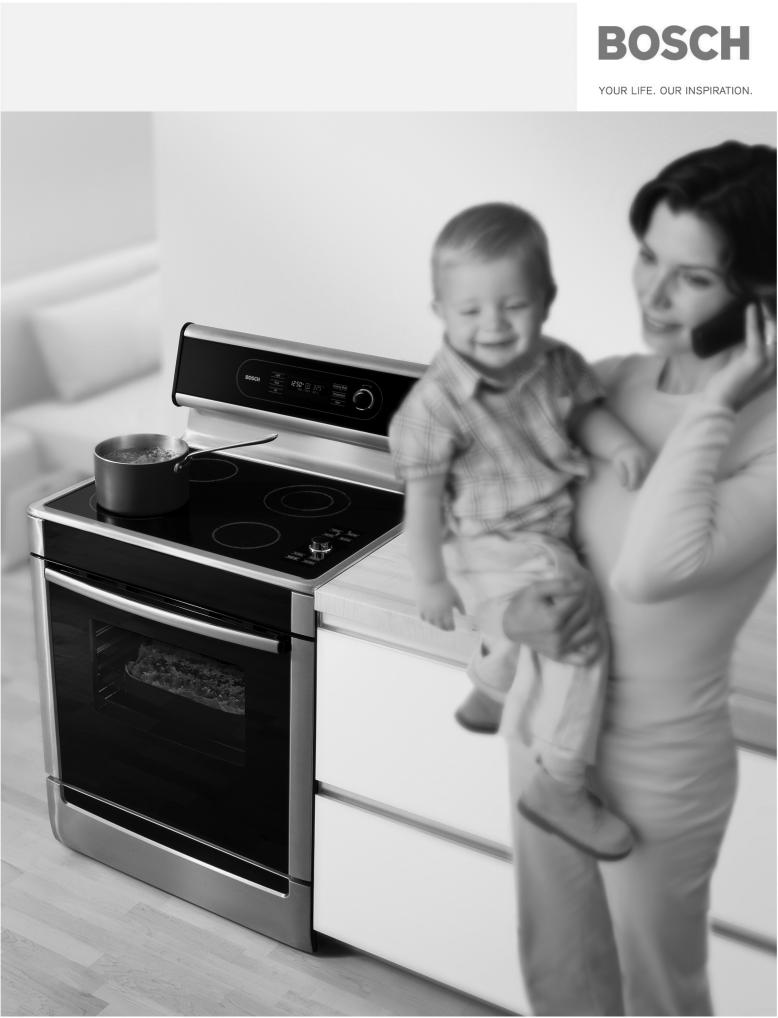
E L E C T R I C F R E E - S TANDING CONVECTION RANGE
Use and Care Manual
For Use with Model(s): mTwisT™ electric range models
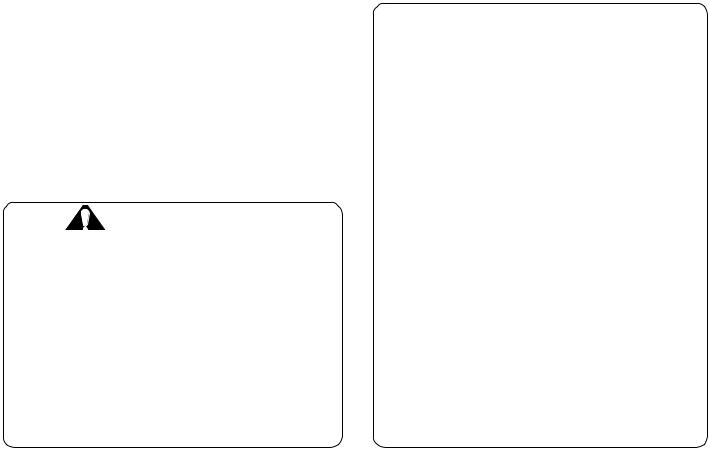
A Special Message
to Our Customers
Dear Bosch Range Owner:
Thank you and congratulations on the purchase of your Bosch Electric Range. Whether you are an expert chef or an aspiring cook, we know that your new range will exceed your expectations. Decades of knowledge and experience are built into this range making it among the highest quality, most versatile and most efficient available.
We ask that you read this manual thoroughly before using your new range. Please pay particular attention to the safety precautions printed at the front of this book and the numerous safety hints and cautions placed throughout. Also, be sure to familiarize yourself with the proper operation of the range and its cleaning and maintenance procedures. Adherence to these instructions and procedures will assure that you realize the full potential of your new Bosch range as well as maintain it for years of dependable use.
Thank you and good cooking,
BSH Home Appliances Corporation
IMPORTANT SAFETY NOTICE
WARNING
When properly cared for, your new Bosch range has been designed to be a safe, reliable appliance. Read all instructions carefully before using this range. These precautions will reduce the risk of burns, electric shock, fire, and injury to persons. Do not operate the oven or cooktop controls if the glass is broken. Food splatter or cleaning solution may penetrate a broken control panel and create a risk of electric shock. Contact a qualified technician immediately should your glass control panel become broken. When using kitchen appliances, basic safety precautions must be followed, including those in the following pages.
The California Safe Drinking and Toxic Enforcement Act requires the Governor of California to publish a list of substances known to the state to cause cancer, birth defects or other reproductive harm, and requires businesses to warn customers of potential exposure to such substances.
The burning of gas cooking fuel and the elimination of soil during self-cleaning can generate small amounts of Carbon Monoxide.
The fiberglass insulation in self-clean ovens gives off very small amounts of formaldehyde during the first several cleaning cycles.
California lists formaldehyde as a potential cause of cancer. Carbon Monoxide is a potential cause of reproductive toxicity.
Exposure to these substances can be minimized by:
1.Providing good ventilation when cooking with gas.
2.Providing good ventilation during and immediately after self cleaning the oven.
3.Operating the unit according to the instructions in this manual.
The Bosch range referred to thoughout this manual is manufactured by BSH Home Appliance Corp.
Table of Contents |
|
Important Safety Instructions .............................................................................. |
1 |
Getting Familiar with Your Range......................................................................... |
3 |
Setting Up Your Range |
|
Setting and Changing the Clock .............................................................................. |
5 |
Setting the Functions ............................................................................................. |
6 |
Accessing and Using the Select Functions Menu ............................................... |
6 |
Volume ........................................................................................................... |
7 |
Change Temperature ....................................................................................... |
7 |
Clock Display .................................................................................................. |
7 |
Demo Mode .................................................................................................... |
7 |
Language Display ............................................................................................ |
7 |
Lock Keys ....................................................................................................... |
7 |
Oven Temp Offset ........................................................................................... |
7 |
Reset Defaults ................................................................................................ |
7 |
Sabbath Feature ............................................................................................. |
8 |
Time Format ................................................................................................... |
8 |
The Cooktop |
|
Cooktop Features ................................................................................................... |
9 |
Operating the mTwisT Cooktop ............................................................................... |
11 |
The Oven |
|
Oven Features (Rack Position) ................................................................................ |
12 |
Oven Modes - Bake, Proof, Warm and Convection Bake ........................................... |
14 |
Oven Modes - Broil and Convection Broil ................................................................. |
15 |
Oven Modes - Convection Roast ............................................................................. |
16 |
Oven Modes - Dehydrate ........................................................................................ |
17 |
Setting the Mode ................................................................................................... |
18 |
Using the Timer (s) ................................................................................................ |
19 |
Using Timed or Delayed Cook ................................................................................. |
20 |
Using the Probe ..................................................................................................... |
21 |
The Warming Drawer ................................................................................................ |
22 |
Care and Cleaning |
|
Cooktop ................................................................................................................ |
24 |
Oven ..................................................................................................................... |
26 |
Self Help, Maintenance, Etc. |
|
Cookware Selection Guide ...................................................................................... |
29 |
Maintenance |
|
Removing the Oven Door ................................................................................ |
30 |
Replacing the Oven Light ................................................................................. |
30 |
Self Help |
|
Cooktop .......................................................................................................... |
31 |
Oven .............................................................................................................. |
32 |
Warranty ............................................................................................................... |
33 |
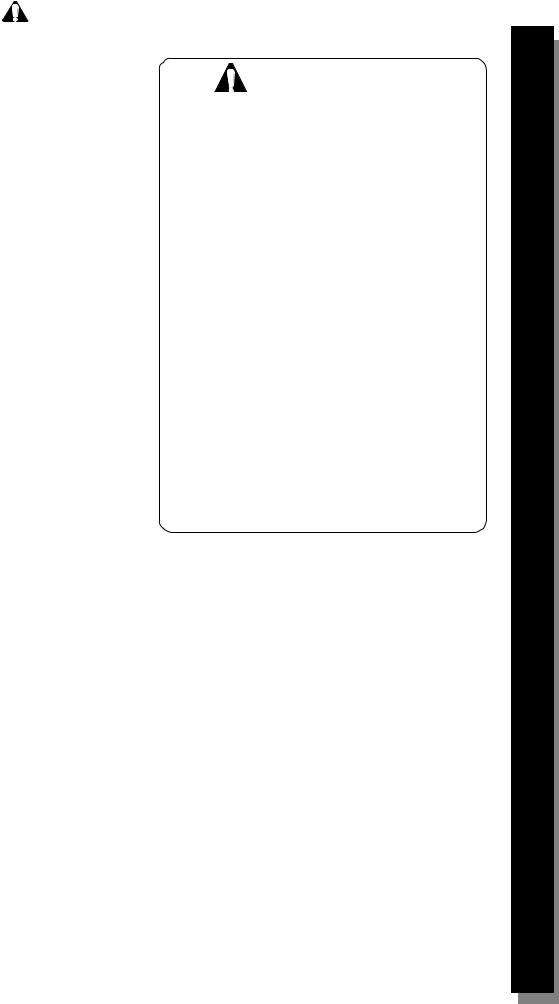
Important Safety Instructions |
... Our Inspiration |
Please read all instructions before using this appliance.
RANGESAFETY
•Have the installer show you the location of the circuit breaker or fuse. Mark it for easy reference.
•This appliance must be properly installed and grounded by a qualified technician. Connect only to properly grounded outlet. Refer to Installation Instructions for details.
•Service should only be performed by an authorized service technician who has undergone training for this specific type of unit. This is a high-tech appliance. Unauthorized service technicians may not be familiar with the sophisticated workings of this appliance, and may therefore cause damage to the unit or create a hazard. Contact the nearest authorized service center for examination, repair or adjustment.
•Do not repair or replace any part of the range unless specifically recommended by an authorized service technician.
•Do not operate this appliance if it is not working properly or if it has been damaged until an authorized servicer has examined it.
•Do not Cook on a broken cooktop. Cleaning solutions and spillovers may create a risk of electric shock.
•Use this appliance only for its intended use as described in this manual. For example, never use the appliance for warming or heating the room. If you have any questions, contact the manufacturer.
•Do not store or use corrosive chemicals, vapors, flammables or nonfood products in this appliance. This type of range is specifically designed to heat or cook food. It is not designed for industrial or laboratory use. The use of corrosive chemicals in heating or cleaning will damage the appliance and could result in injury.
•Secure all loose garments, etc. before beginning. Tie long hair so that it does not hang loose, and do not wear loose fitting clothing or hanging garments, such as ties, scarves, jewelry, or dangling sleeves.
•Avoid reaching or leaning over the appliance.
Be aware that certain clothing and hair sprays may contain flammable chemicals that could be ignited if brought in contact with hot surface units or heating elements and may cause severe burns.
•In the event that personal clothing or hair catchesfire,DROPANDROLLIMMEDIATELY to extinguish flames.
•Do not touch the cooking area(s) or the immediate surrounding area(s) while using the range or while it is cooling. Areas adjacent
to the burners, oven and warming drawer may become hot enough to cause burns and my be hot even though they are off. Never let clothing, potholders, or other flammable materials come in contact with a cooking area until it has cooled.
PERSONAL SAFETY
WARNING
To reduce the risk of injury to persons, in the event of a grease fire, observe the following:
•In the event of a grease fire, SMOTHER FLAMES with a close-fitting lid, cookie sheet, or other metal tray, then turn off the elements. BE CAREFUL TO PREVENT BURNS. If the flames do not go out immediately, EVACUATE AND CALL THE FIRE DEPARTMENT.
•Do not use water, including wet dishcloths or towels, on grease fires. A violent steam explosion may result.
•SMOTHER FLAMES from other types of food fires with baking soda. NEVER use water on cooking fires.
•NEVER PICK UP A FLAMING PAN. You may be burned.
•ALWAYS have a working SMOKE DETECTOR near the kitchen.
•LEAVE THE HOOD VENTILATOR ON when flambéing food.
•UseanextinguisherONLYIF:
•You know you have a Class ABC extinguisher, and you already know how to operate it.
•The fire is small and contained in the area where it started.
•The fire department is being called.
•You can fight the fire with your back to an exit.
•Keep Oven Vent Ducts Unobstructed.
•Do not clean the range while it is still hot.
Some cleaners produce noxious fumes when applied to a hot surface.
•Exercise caution when opening the oven or warming drawer. Standing to the side, open the door slowly and slightly to let hot air and/or steam escape. Keep your face clear of the opening
and make sure there are no children or pets near the unit. After the release of hot air and/or steam, proceed with your cooking. Keep doors shut unless necessary for cooking or cleaning purposes. Do not leave open doors unattended.
•Do not heat or warm unopened food containers either in the oven or the warming drawer. Build-up of pressure may cause the container to burst and cause injury.
•Always place oven racks in desired location while oven is cool. If a rack must be moved while oven is hot, do not let potholder contact the hot heating elements.
•Always use dry potholders. Moist or damp potholders on hot surfaces may result in burns from steam. Do not use a towel or other bulky cloth.
•Do not use water or a wet rag or towel on a grease fire. Smother fire with baking soda or use a dry chemical or foam-type (ABC) extinguisher.
Cooktop The - Use Started Getting
Help Self Cleaning and Care
English • 1
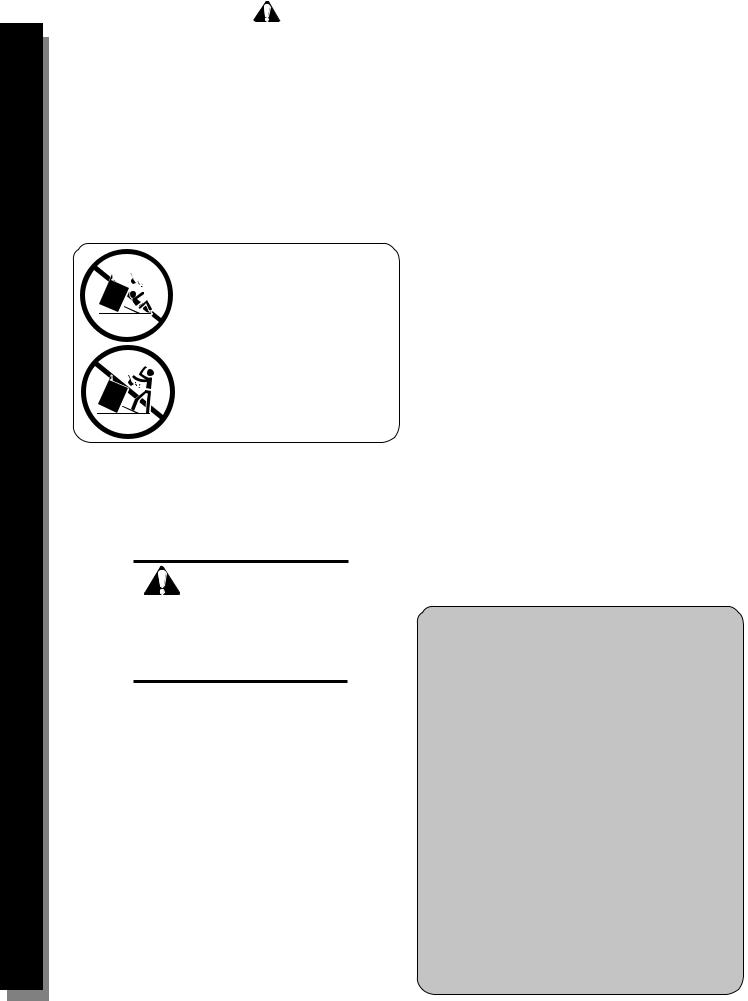
Your Life ... |
Important Safety Instructions |
Use - The Cooktop Getting Started
Self Help Care and Cleaning
•Have an appropriate fire extinguisher available, nearby, highly visible and easily accessible near the oven.
•Keep the oven and ventilating hood free from grease build up. Clean them frequently.
•Do not place food directly on oven bottom.
•Follow the manufacturer’s directions when using cooking or roasting bags.
•Do not allow anyone to climb, stand, lean, or sit on any part of the oven, nor to hang on the oven door, warming drawer, or storage drawer.
This can damage the range, and the unit may tip over, potentially causing severe injury.
 WARNING
WARNING
• ALL RANGES CAN TIP.
•INJURY TO PERSONS COULD RESULT.
•INSTALL ANTI-TIP DEVICE
PACKAGED WITH RANGE.
SEE INSTALLATION INSTRUCTIONS.
•Do not allow children to use this appliance unless closely supervised by an adult. Children and pets should not be left alone or unattended in the area where the appliance is in use. They should never be allowed to sit or stand on any part of the appliance or to play in its vicinity, whether or not the appliance is in use.
CAUTION
Items of interest to children should not be stored in the range, in cabinets above the range or on the backsplash of the range. Children climbing on the range to reach items could be seriously injured.
•If materials inside the oven should ignite, keep oven door closed. Turn off oven and disconnect the circuit at the circuit breaker box.
•Use high heat settings on the cooktop only when necessary. Heat oil slowly on no more than a low-medium setting, to avoid bubbling and splatter. Hot oil is capable of causing extreme burns and injury.
•Never move a pan of hot oil, especially a deep fat fryer. Wait until it is cool.
•Never leave the cooktop unattended. Boilovers can cause smoke and possibly damage the cooktop.
•Hold the handle of the pan to prevent movement of the utensil when stirring or turning food.
•Use only utensils that are appropriate for ceramic cooktop use on the cooktop. Use proper pan size. (See Cookware Selection Guide”, page. 26 for further details). Select utensils with flat bottoms that cover the entire surface unit. This will reduce risk of fire and also increase efficiency.
Utensils not approved for use with ceramic cooktops may break with sudden temperature changes.
•Always position handles of utensils inward so they do not extend over adjacent work areas, burners or the edge of the cooktop.
SELF-CLEANINGSAFETY
•Confirm that the door locks and will not open once the door lock icon appears. If the door does not lock, touch OFF and do not run Self-Clean.
Phone 800-944-2904 for service.
Note: During a normal Self Clean cycle, the door does not lock at the beginning of the cycle; However, it does lock prior to reaching the high self clean temperatures. In a Delayed Self-Clean cycle, the door locks immediately.
•Do not clean the oven gasket. It is essential for a good seal. Care should be taken not to rub, damage, move or remove the oven gasket.
•Do not use commercial oven cleaners or oven liner protective coatings (such as aluminum foil) of any kind in or around any part of the oven.
•Clean only oven parts listed in this manual.
•Remove the broiler pan, oven racks, oven probe and other utensils and wipe out excess soft spillage before self-cleaning the oven.
REGARDINGPETBIRDS:
Birds have very sensitive respiratory systems. Keep pet birds out of the kitchen or other rooms where kitchen fumes could reach them. During self clean, fumes are released that may be harmful to birds. Other kitchen fumes such as overheating margarines and cooking oils may also be harmful.
RANGEOPERATIONOVERVIEW:
Operation of the range is through touch pads on the backguard, touch pads on the cooktop, the dial on the backguard and the mTwist magnetic dial on the cooktop.
The backguard touch pads, in conjunction with the dial on the backguard, are used to select an oven mode, set the time(s) and to set up your range. To use the touch pad, touch the center part of the pad with the flat part of your fingertip. A beep will sound to indicate that the selection has been made. Turn the dial on the backguard to the desired setting and press start.
Use the touchpads on the cooktop to choose the element and the element size. These touchpads can also be used to turn the cooktop on and off and to lock the cooktop touchpads.
The mTwist dial is used to select cooktop heat settings. Touch the element pad and turn the mTwist dial to the desired setting.
See the sections on operating the cooktop, oven and warming drawer for detailed instructions.
2 • English

|
Getting Familiar With Your Range |
... Our Inspiration |
||||
Parts Included with Your Range: |
|
|
|
|
Getting |
|
1. Anti-Tip Bracket |
|
|
|
|
||
|
|
|
|
|
||
2. |
Bosch Cookbook |
|
Anti-Tip Bracket |
|
|
|
3. |
Broiler Pan and Grid |
|
|
|
||
4. |
Cooktop Cleaning Creme |
|
|
|
|
|
5. |
Cooktop Scraper |
|
|
|
|
Started |
6. |
Literature Kit: |
|
|
|
|
|
|
Quick Reference Guide |
|
|
|
|
|
|
|
|
|
|
|
|
|
Use & Care Manual |
|
|
Oven Rack, Flat |
|
|
|
Installation Instructions |
|
|
|
|
|
|
AHAM Anti-Tip Brochure |
|
|
|
|
|
|
AHAM Safer Cooking Brochure |
|
|
|
|
|
|
Warranty/ Registration Card |
|
|
|
|
|
7. |
Oven Racks, Flat (2 or 3;varies by model) |
|
|
|
|
Use |
8. |
Oven Rack, Full Extension (some models) |
|
|
|
|
|
9. |
Probe (some models) |
|
|
|
|
|
10. Warming Drawer Rack (some models) |
|
|
|
|
||
|
Probe |
|
|
|
|
- |
|
|
|
|
|
The |
|
|
(some models) |
|
|
|
|
|
|
|
|
|
|
Cooktop |
|
|
Oven Rack, Full Extension |
|
||||
|
|
|
||||
|
|
|
(some models) |
|
|
|
|
|
|
|
Warming Drawer Rack |
|
|
|
|
|
|
(some models) |
Care |
|
Drawings are not to scale. |
|
|
|
|
||
|
|
|
|
|
||
|
13 |
|
|
|
|
and |
|
18 |
|
15. |
Broil Element |
|
Cleaning |
|
25 |
|
Range Parts: |
|
|
|
|
|
|
11. |
Incandescent Lights (back wall) |
|
|
|
|
|
12. |
Oven Control Panel |
|
|
|
14 |
|
13. |
Oven Control Knob |
|
|
|
|
14. |
mTwisT Dial |
|
|
|
|
|
|
|
|
||
|
|
|
16. |
Convection Fan and Element |
|
|
17 |
|
19 |
17. Probe Receptacle (some models) |
|
||
|
18. |
Rack Guides |
|
Self |
||
|
|
|
||||
|
|
|
19. |
Door Gasket |
|
|
|
|
|
|
|
||
|
|
|
20. |
Model & Serial # Plate |
|
|
|
|
|
21. |
Bake Element |
|
Help |
24 |
|
|
22. |
Oven Door Lock |
|
|
|
|
|
|
|||
|
|
23. |
Broiler Pan |
|
|
|
20 |
|
|
|
|
||
|
|
24. |
Warming Drawer |
|
|
|
|
|
|
|
|
||
|
|
|
25. |
Oven Vent |
|
|
English • 3
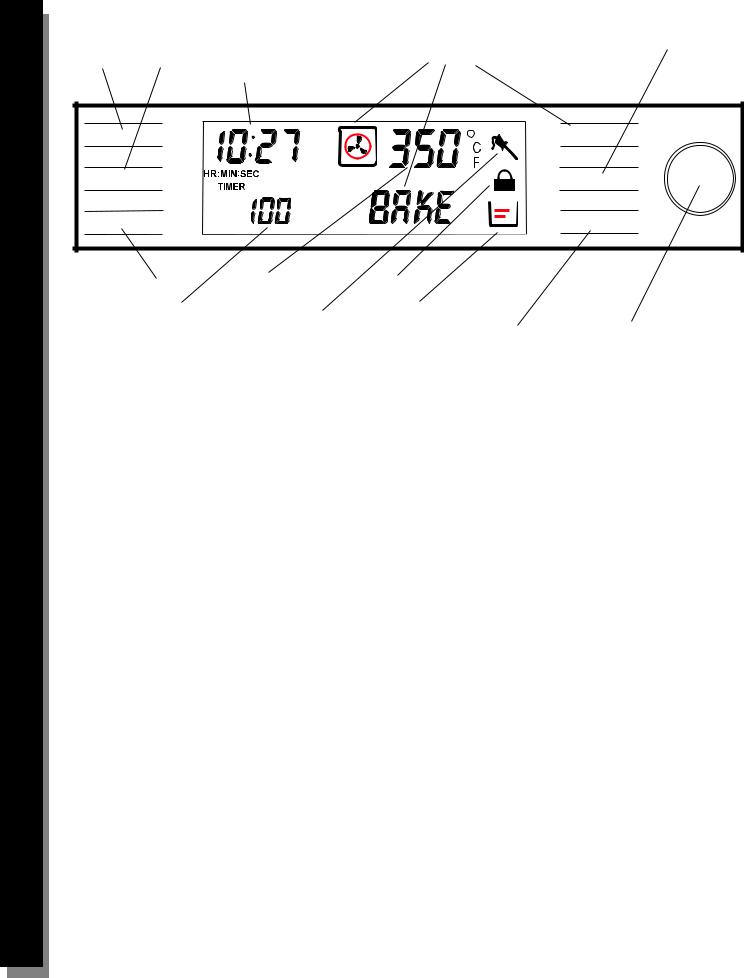
Your Life ...
Started |
Light |
Getting |
Light |
|
|
|
Time |
|
Off |
|
Getting Familiar With Your Range |
|
|
The Oven Control Panel |
|
|
Cooking Mode |
Temperature |
Time |
|
|
|
Clock |
|
|
AM |
Cooking Mode |
|
|
|
|
PM |
|
|
BAKE |
Temperature |
|
|
|
|
|
Start |
Use - The Cooktop
Self Help Care and Cleaning
|
Oven |
Lock |
|
|
Off |
Temperature |
Indicator |
|
|
|
|
|
||
Preheat or Probe |
Probe |
Warming |
|
|
Temperature |
|
|
||
Drawer |
|
|
||
Indicator |
Start |
|
||
|
Control |
|||
|
Indicator |
|||
|
|
|||
|
|
|
Knob |
|
|
|
|
|
Display Window Features
CLOCK– Shows the time of day with a 12 hour or 24 hour clock option.
COOKING MODE - Touch pad to display cooking mode.
COOKINGORTIMEDMODE – Shows the number of hours and minutes the oven will be “on.” Cooking mode icon is also displayed when cooking mode is selected.
CONTROL KNOB - Used to set the clock, timers, select cooking mode and temperature. Turn clockwise to
increase and turn counterclockwise to decrease. LIGHT - Touch pad to turn oven light on or off.
DOOR LOCK INDICATOR - Icon is displayed during the self-clean mode when the door is locked. DO NOT attempt to open the door until the lock symbol is no longer present.
OFF - Touch pad to turn off oven and/or warming drawer.
OVEN TEMPERATURE - Shows the oven temperature selected.
PREHEAT - Displays temperature of oven during preheat mode. Also displays internal temperature of meat when probe is in use.
PROBE INDICATOR - Indicates the probe is installed in oven. The internal temperature of the meat is displayed in place of the preheat temperature.
START - Touch pad to complete an entry.
TEMPERATURE - Touch pad to select cooking temperature.
TIME - Touch pad to select cooking time.
TIMER – There are two timers - TIMER 1 AND TIMER 2; Each counts down the time in hours and minutes. With less than 60 minutes remaining, the timer also displays seconds.
WARMINGDRAWERINDICATOR-Icon displays when warming drawer is in use. Indicates warming drawer setting.
Other Indicators and Features
BEEP - Signals that more information must be
entered or confirms the receipt of an entry. A Beep also signals the end of a program or an oven error.
DEFAULT SETTINGS - The cooking modes
automatically select the default temperature. These can be changed when a different one is needed.
FLASHING SYMBOL OR NUMBER - Signals an
incomplete setting and calls for another step or START to be touched.
F NUMBER CODES - These codes are displayed when there is a problem with the range.
CONVECTION FAN - The convection fan operates
during any convection mode and the self clean mode. When the oven is operating in the convection mode, the fan will turn off automatically when the door is opened except when in the dehydrate mode.
4 • English

|
Setting Up Your Range |
|
|
... Our Inspiration |
||
Setting the Clock (after power to the range has been off) |
|
|
|
Getting |
||
• |
The oven is preset to a 12 hour clock and indicates AM and PM. |
|
|
|
||
• |
Always set the clock after installation or after a power failure. Once power returns to the oven, the clock defaults |
|
||||
|
to 12:00 am. |
|
|
|
|
|
• |
The time of day is displayed in hours and minutes. |
|
|
|
|
|
• |
The clock time will appear during all oven operations except when the timer and oven are running. Turn knob to |
|
||||
|
display clock when timer is displayed. |
|
|
|
|
|
• |
The clock display can also be turned off (See Clock Display, Page 5).. |
|
|
|
Started |
|
Note: To switch to a 24 hour clock, see "Select Function” |
|
|
|
|||
|
|
|
|
|||
section. |
|
|
|
|
||
1. |
CLOCK will be displayed and the hour digits will |
12: 00 |
AM |
CLOCK |
|
|
|
|
|
||||
|
flash. |
|
|
|
|
|
|
Turn knob to select hour and AM or PM. |
|
|
|
-Use |
|
2. |
Touch TIME. CLOCK will still be displayed and the |
|
|
|
||
|
|
|
|
|||
|
minute digits will flash. |
|
|
|
|
|
3. |
Turn knob. Set minutes. |
|
|
|
The |
|
4. |
Touch TIME and the clock is now set. |
BEEP REMINDER |
||||
If operation is not completed, |
||||||
|
|
|||||
|
|
the oven will beep periodically |
Cooktop |
|||
|
|
as a reminder to set clock |
||||
|
|
|
||||
time.PushOFF.
Changing the Clock Time
1.Touch Time. TIMER 1 will flash in display.
2.Turn knob to select CLOCK .
3.Touch TIME again and hour digits will flash.
4.Turn knob to change hours.
5.Touch TIME again and minute digits will flash.
6.Turn knob clockwise or counterclockwise to change minutes.
7.Touch TIME again and the clock is set.
0: 00 AM
HR:MIN |
TIMER 1 |
TIMER |
|
Helpful Hint
To cancel the TIME selection when setting the clock,touch OFFatanytime while in the clock mode.
Help Self Cleaning and Care
English • 5
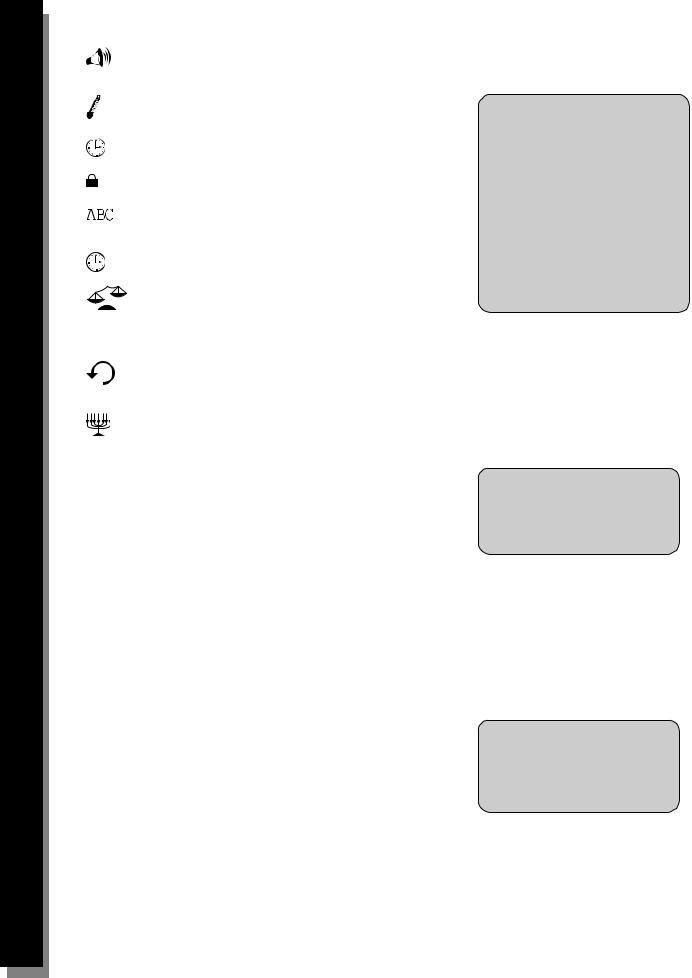
Your Life ... |
Setting Up Your Range |
Use - The Cooktop Getting Started
Self Help Care and Cleaning
SELECT FUNCTIONS is the section of the menu where you can set or change the following features on your range:
VOLUME(decreaseorincreaseloudness of control beeps)
|
|
TEMPERATUREFORMAT(switchtemperature |
TIPS on Using Functions |
|
|
scale to Fahrenheit or Celsius) |
|
|
|
TIMEFORMAT(12houror24hour) |
• There will be a slight delay |
|
|
before each message (or |
|
|
|
|
|
|
|
LOCKKEYS(ovencontrolpadlockout) |
feature) can be seen in the |
|
|
display. |
|
|
|
|
|
|
|
LANGUAGEOPTION(fordisplay;selectEnglish, |
• Turn knob slowly, and wait |
|
|
approximately one second for |
|
|
|
Spanish, or French) |
|
|
|
display to show next feature. |
|
|
|
|
|
|
|
CLOCKDISPLAY(yesorno) |
• To move through the feature |
|
|
menu, slowly turn the knob |
|
|
|
|
|
|
|
OVENTEMPERATUREOFFSET(usedto |
clockwise one click after each |
|
|
feature appears. |
|
|
|
calibrate the oven temperature) |
|
DEMO |
|
||
DEMOMODE(usedbyappliancestores) |
|
||
|
|
|
|
RESETDEFAULTS(changeallfunctionsettings back to original factory settings)
SABBATH FEATURE(forreligiousfaithswith “no work” requirements on the Sabbath)
BEEPS
Accessing and Using the Select
Functions Menu
To access the SELECTFUNCTIONS menu, touchand hold COOKING MODE touch pad for five (5) seconds.
SELECT FUNCTION is displayed.
1.Turn knob to desired feature.
2.Press START to choose any function, and turn knob to choose any sub-functions.
3.After selecting feature, touch OFF.
See next page for further information.
To indicate when a mode is finished, 3 consecutive beeps will sound.
NOTE:
In the event of a power failure, thefunctionsreturntothefactory settingsand will need to bereset.
6 • English
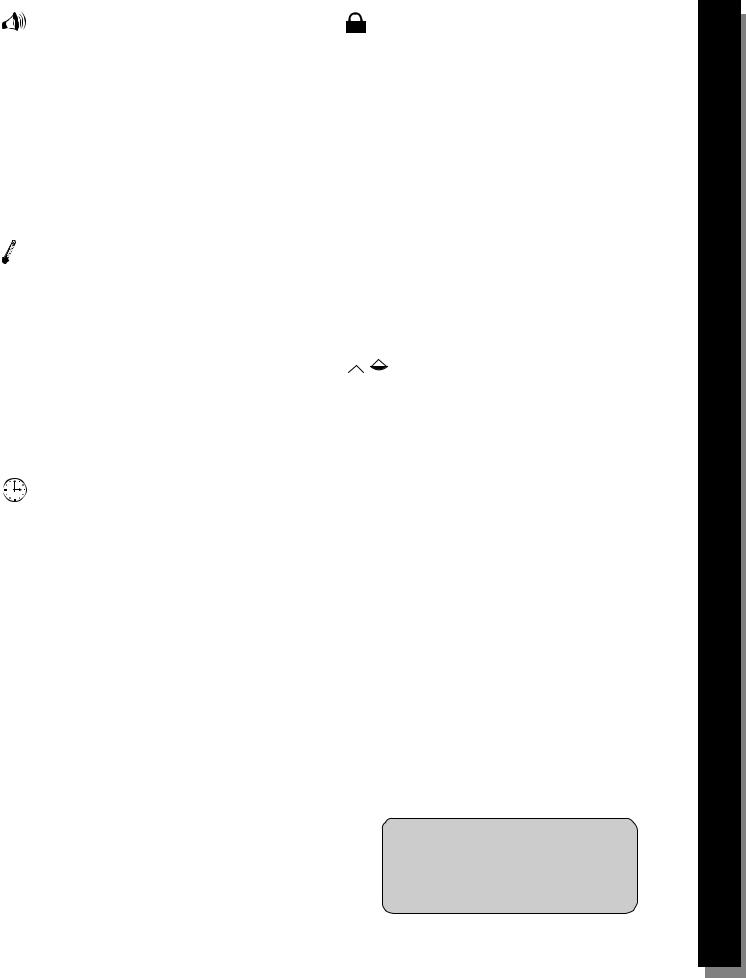
Setting Up Your Range |
... Our Inspiration |
BEEP VOLUME
•The volume of the control beep can be changed from LOW (softest) to HIGH (loudest).
•The control default for beep volume is Medium.
Changing the Beep Volume
1.AccessSELECTFUNCTIONMenu.
2.Turn knob clockwise until VOLUME is displayed.
3.TouchSTART.
4.Turn knob to select volume level Low, Medium or High.
5.TouchSTART.
CHANGE TEMPERATURE
•The oven has been preset to the Fahrenheit temperature scale.
•The feature allows you to switch between Fahrenheit and Celsius temperature.
Changing the Temperature Scale
1.AccessSELECTFUNCTIONMenu.
2.Turn knob clockwise until SELECT TEMP F-C is displayed.
3.TouchSTART.
4.Turn knob to select Fahrenheit (F) or Celsius (C).
5.Touch START to accept new selection.
CLOCK DISPLAY (ON or OFF)
•Clock time display can be turned off.
•The default display is on.
TurningtheClockDisplayONorOFF
1.AccessSELECTFUNCTIONMenu.
2.Turn knob clockwise until CLOCK DISPLAY is displayed.
3.Touch START.
4.Turn knob once and ON or OFF will appear in display.
5.Touch START to accept new selection.
DEMO DEMO MODE
The demo mode is for appliance store use only.

 LANGUAGE DISPLAY
LANGUAGE DISPLAY
•Language choices are English, Spanish, and French.
•English is the default language.
Changing the Language Display
1.AccessSELECTFUNCTIONMenu.
2.Turn knob clockwise until desired language is displayed.
3.TouchSTART.
4.Turn knob clockwise to select a different language.
5.Touch START to accept a language change.
LOCK KEYS
•The oven keypad can be locked for safety purposes.
•This feature can be used to prevent changes to the oven function.
Locking or Unlocking the Oven Control Panel
1.AccessSELECTFUNCTIONMenu.
2.Turn knob clockwise until LOCK KEYS is flashing.
3.Touch START. KEY PAD LOCKED is displayed. The display will beep if a key is pressed to indicate that the keypad is locked.
4.Tounlock keypads, touch COOKINGMODE and hold for 5 seconds. Display will read UNLOCKING
KEYPAD.
Note: This function DOES NOT lock oven door.

 OVEN TEMPERATURE OFFSET
OVEN TEMPERATURE OFFSET
•This feature allows the adjustment of the oven temperature if food is consistently too brown or too light.
Changing the Oven Temp Offset
1.AccessSELECTFUNCTIONMenu.
2.Turnknob clockwise until OVENTEMPOFFSET is displayed.
3.Touch START. 0° F is displayed.
4.Turn the knob to the right to increase temperature +25° F and to the left to decrease -25° F temperature.
5.Touch START to accept a temperature change.
 RESET DEFAULTS
RESET DEFAULTS
•This feature is used to change all the “Select Functions” settings back to the original factory settings (or defaults).
Resetting the factory settings.
1.AccessSELECTFUNCTIONSMenu.
2.Turn knob clockwise until RESETDEFAULTS is displayed.
3.TouchSTART. Display reads SELECT FUNCTIONS.
NOTE:
TheSELECTFUNCTIONmenuis displayed in English only, regardless of language selected.
Cooktop The - Use Started Getting
Help Self Cleaning and Care
English • 7

Your Life ... |
Setting Up Your Range |
Use - The Cooktop Getting Started
Self Help Care and Cleaning
SABBATH FEATURE
•The oven will bake for 73 hours before automatically turningoff.
•Oven or warming drawer cannot be operating to set the Sabbath Feature.
Setting the Sabbath Feature
1.AccessSELECTFUNCTIONSMenu.
2.Turnknob clockwise until SABBATHOPTION appears.
3.Touch START. BAKE will show in display and temperature will flash.
4.Turn knob to set oven temperature.
5.Turn oven light on if desired (touch LIGHT). Note: The light cannot be changed after this point. It will stay on or off, as selected, during the entire Sabbath mode.
6.Touch START. Oven starts after 5 seconds.
Note: The probe CANNOT be used during the Sabbath mode.
While baking in Sabbath mode, the display will show SABBATH and the BAKE icon will be displayed. The clock will be off and no temperature will show in the display.
During the Sabbath mode, only the OFF key will operate.
Press Off at any time during the Sabbath mode to end the mode and turn off the oven.
At end of 73 hours, the oven will turn OFF automatically and the display will show SABBATH END. Touch OFF to return to time of day.
TIME FORMAT
•The clock can be set to a 12 hour or 24 hour format.
•The oven default for clock format is 12 hour.
Changing the Time Format
1.AccessSELECTFUNCTIONMenu.
2.Turn knob clockwise until TIME FORMAT is displayed.
3.TouchSTART.
4.Turn knob to select 12 hour or 24 hour format.
5.Touch START to accept new selection.
8 • English

Cooktop Features |
... Our Inspiration |
Before Using the Cooktop
•Remove all packing materials and labels from the cooktop surface.
•While cool, wipe with a clean, damp sponge and dry.
•Apply the Cooktop Cleaning Creme packaged with the range. Buff with a clean cloth. See Care and Cleaning Section.
•There may be a slight odor during the first several uses; this is normal and will disappear.
•Optimum cooking results depend on the proper cookware being selected and used.
•The cooking surface will hold the heat and remain hot up to 30 minutes after the elements have been turned off.
•Read and understand all safety precautions and Use and Care Manual information prior to operating.
Precautions for Long Life and Good Appearance of the Surface
•Regular, daily care using the Cooktop Cleaning Creme will protect the surface and make it easier to remove food soil and water spots.
•The ceramic glass cooking surface is a durable material resistant to impact but not unbreakable if a pan or other object is dropped on it.
•Never cook food directly on the glass.
•Avoid placing a wok support ring, trivet or other metal stand on the glass surface.
•Do not use the glass surface as a cutting board.
•Do not slide cookware across the cooking surface; it may scratch the glass.
•Do not place wet pans on the glass surface.
Retained Heat
The glass cooking surface retains heat and stays hot after the element(s) have been turned off. The retained heat may be used to hold foods at serving temperatures for a short time. If a hot surface light is on, use caution when working or cleaning around the cooktop as the cooktop is still hot.
Temperature Limiters
Each radiant heating element has its own sensor to protect the glass cooking surface from extreme high temperatures. The limiters will operate automatically by cycling the element off regardless of the cook setting. Although cycling is normal, any one of the following conditions can activate the limiter and cause it to cycle on and off more than usual:
•The base of the pan is not making full contact with the heating surface (due to a warped or uneven base).
•The pan is too small for the element.
•The pan has boiled dry.
•The material or shape of the pan is slow to transfer the heat.
Radiant Elements
Bosch UltraSpeedTM radiant elements use a wire ribbon located under the ceramic glass surface to provide the heat for cooking. These radiant elements will cycle on and off by design (see Temperature Limiters at left.)
There are 9 heat setting positions from 9 (high) to 1 (low) and a special setting for keep warm.
Dual Element
The dual element consists of two radiant ribbon elements within the same heating area. Either the small inner element or both the inner and outer elements may be selected for use, depending on the size of cookware.
Triple Element (Some Models)
The Triple Element, located in the left front position, consists of three radiant ribbon elements within the same heating area, one, two or three elements can be selected.
•The default setting is the largest element.
•Touch POT SIZING once for medium size.
•Touch POT SIZING twice for small size.
Cooking Guide
Use this chart as a guide for heat settings*:
|
Uses |
Heat |
|
|
Settings |
|
Bringing water to boil |
9 |
|
|
High |
|
|
|
|
Pan frying, sauteing, |
6-8 |
|
browning meat, deep |
Med-High |
|
fat frying |
|
|
|
|
|
Most frying, eggs, |
4-5 |
|
pancakes, slow boil |
Med |
|
|
|
|
Simmering, finish cooking |
2-3 |
|
covered foods, steaming |
Med Low |
|
|
|
|
Melting butter and |
1 |
|
chocolate |
Low |
|
|
|
|
Keeping food warm |
L |
|
Keep Warm |
|
|
|
|
|
|
|
*A range of heat settings are listed because the actual setting depends on (1) type and quality of pan (See “Selecting Cookware”, Page 28), (2) type, quantity and temperature of the food, (3) element used and (4) the cook’s preference.
208/240 Volt Connection: The Heat Settings recommended on this page are based on a 240 volt power source. If your cooktop is connected to 208 volts, the same heat settings apply but foods may take a little longer to finish cooking.
Cooktop The - Use Started Getting
Help Self Cleaning and Care
English • 9

Your Life ... |
Cooktop Operation |
Use - The Cooktop Getting Started
Self Help Care and Cleaning
Depending on model, the mTwisT Cooktop has either two (2) single elements (small and medium) and two (2) double elements, or two (2) single elements, one (1) double element and one (1) triple element. The mTwisT dial is a magnetic removable dial, which allows for easy cleaning of the smooth ceramic glass cooktop.
|
|
|
12 |
6 |
|
|
|
|
H |
1 |
|
2 |
7 |
8 |
|
|
|
|
|
|
|
|
|
9 |
|
4 |
3 |
|
|
|
|
|
|
|
|
|
7 |
|
10 |
|
|
|
|
|
Double Element Models |
11 |
|
||
|
|
|||
1 |
2 |
|
5 |
3 |
|
7
Triple Element Models
NO. TYPE/SIZE |
WATTAGE |
1.Single 7"1500
2. |
Dual 5"/ 8" |
800/ 1900 |
3.Single 6"1200
4. |
Dual 5"/ 9" |
1100/ 2500 |
5. |
Triple 5"/ 7"/ 9" |
800/ 1600/ 2500 |
6.Dual Element ON Indicator Light
one light: inner and outer elements are on no light: inner element is on
7.Triple Element ON Indicator Lights two lights: all three elements are on
one light: middle and inner elements are on no lights: inner element is on
8.Heating Elements Selector Pads
9.mTwisT Dial Location
10.Function Pads
11.POWER OFF Pad
12.Hot Surface Indicator Light
Dial
The cooktop uses an mTwisT magnetic dial to select the desired heat setting. The mTwisT dial is held onto the cooktop by a strong magnet and automatically positions itself in the center of the dial location when placed on the cooktop.
Note: If the dial is removed from the cooktop when in use, all elements will be turned off after 10 seconds. The cooktop is locked and the Panel Lock light comes on. (See Setting Panel Lock on Page 11.)
Element ‘ON’ Indicator Light
The area above the element touch pad being used will show the cook setting when the element is on (See Hot Surface Indicator Light graphic above). When the element is turned off, the hot surface indicator comes on in this area.
Hot Surface Indicator Light
Each element features a hot indicator light to show when the cooking surface is too hot to touch. A letter H will appear above the element touch pad.
The light remains on until the cooking area has cooled to a safe-to-touch temperature.
If a hot surface light is on, use caution when working or cleaning around the cooktop as the cooktop is still hot.
Keep Warm
Each element has a keep warm setting to keep hot, cooked foods at serving temperatures.
To set Keep Warm feature:
1.Touch element pad for desired element.
2.Touch KEEP WARM pad. L is displayed above selected element and element comes on.
Keep Warm Guidelines
Use pans/utensils with flat bases. Plates and casseroles with shallow ridges around the base can be used provided they are made of heat-safe materials.
Keep dish covered to keep foods hot. Do not use paper or plastic.
Choose pans and cookware that may be safely used on a hot surface. Example: Use CorningWare® "Safe for Rangetop" rather than Pyrex® which is not recommended for cooktop use.
Use a trivet or steamer inside a pan when necessary to raise food off bottom of pan.
10 • English

Cooktop Operation |
... Our Inspiration |
General Operation of Cooktop
The range has touch pads and a magnetic dial to operate the cooktop. When touching the glass of a touch pad, such as an element or function pad, use the flat part of the finger and touch the center of the pad. A beep will sound when touching any of these pads.
Operation with the mTwist Dial
1.Place pan on element.
2.Touch element pad for desired element. Display will show a 0.
3.For single elements, proceed to step 4.
For dual or triple elements, touch POT SIZING pad. The control defaults to largest size element.
Touch the POT SIZING element pad again to select a smaller element. Touching the POT SIZING pad repeatedly alternates between the element sizes.
When a dual element is selected, one light is displayed above the corresponding element touch pad.
When a triple element is selected, 2 lights are displayed above the corresponding element touch pad.
4.Turn the mTwisT dial until the desired heat setting is displayed.
Changing Heat Setting While Cooking
1.Touch element pad for element desired. Display will show 0.
2.Turn dial. The first turn of the mTwisT dial will display the current cook setting.
3.Turn dial to new cook setting. The new cook setting is displayed.
To Turn Off One Surface Element
1.Touch element pad for desired element.
2.Display shows 0. After 5 seconds the element shuts off. The element shuts off right away if the pad is touched a second time.
To Turn Off All Elements at the Same Time
1.Touch POWER OFF pad or remove mTwisT dial from cooktop. Once removed, the cooktop controls are locked after 10 seconds.
2.Replace mTwisT dial then touch and hold PANEL LOCK pad for five seconds to unlock control.
 CAUTION
CAUTION
•Foodspackagedinaluminumfoil should not be placed directly on the glass ceramic surface for cooking; aluminum foil can melt and cause permanent damage.
•Plastic, paper and cloth can melt or burn when in contact with a hot surface. Do not let these items come in contact with the hot glass ceramic surface.
•Do not allow pans to boil dry. This can permanently damage the pan, the element and the cooktop glass.
Operation without the mTwisT Dial
The cooktop can also be operated without the mTwisT dial.
1.Turn off Panel Lock (see “Setting Panel Lock”, below).
2.Touch element pad for desired element. Display shows 0.
3.Choose the POT SIZING pad (if using dual or triple element).
4.Touch element pad repeatedly until desired heat setting is displayed.
Change Heat Setting
1.Select element pad for desired element.
2.Each touch of the element pad changes setting. Continue touching repeatedly until desired heat setting is displayed.
Change Pot Size - (for dual and triple elements only)
1.Select element pad for desired element.
2.Touch POT SIZING pad for desired pad.
3.Touch element pad until desired heat setting is displayed.
Turn Off Element
1.Touch element pad.
2.Touch element pad until 0 is displayed. For several elements, select POWER OFF pad.
Cooktop Function Pads
Panel Lock
The panel lock is selected to prevent the cooktop from being turned on, such as for cleaning. The elements will not function when Panel Lock is turned on.
Setting Panel Lock (cooktop only)
1.Touch and hold PANEL LOCK pad for five seconds. A light above the pad stays lit when the panel is locked.
2.To unlock touch the PANEL LOCK pad and hold for five seconds. The light above the pad will disappear.
The cooktop cannot be locked when a surface element is operating. It is recommended to lock the cooktop
before cleaning. Power Off
Power Off turns off all elements at the same time. The indicator light above the POWER OFF pad is lit when at least one element is on. The light will turn off when the POWER OFF pad is touched or all elements are turned off.
PotSizing
Use this pad to choose the pot size on dual and triple elements.
1.Touch element pad. Control defaults to larger element. Dual or triple element light comes on above element pad indicating large size is selected.
2.Touch POT SIZING pad to change to smaller element. Dual or triple element light will turn off.
3.Turn mTwisT dial to desired heat setting.
To change element size for different size cooking pot when the element is on:
1.Touch element pad. Display will show 0.
2.Touch POT SIZING pad to change element size chosen, element turns off.
3.Turn mTwisT dial to desired heat setting.
Cooktop The - Use Started Getting
Help Self Cleaning and Care
English • 11

Your Life ... |
Oven Modes and Features |
Oven Racks
Getting Started
Depending on model, the range is equipped with either three flat racks or two flat racks and one full extension rack. The racks are designed with a stop so they will stop before coming completely out of the oven and not tilt.
The Flat Rack
Rack
Inserttoward
with back
|
|
rack |
|
of |
|
back |
range |
|
wall |
of |
|
|
|
|
Back of Rack
Pan Stops
Back of Rack
Top Rack
Bottom Rack
Stops |
Rack |
|
Guide |
||
|
Top
Rack
Rest
Use - The CooktopOven
Self Help Care and Cleaning
Front of Rack
CAUTION:
To avoid possible burns, place oven racks in desired positions before turning the oven on. Always use oven mitts when the oven is warm. If a rack must be moved while the oven is hot, do not let oven mitts contact hot heating elements.
Removing from oven: Grasp rack firmly on both sides and pull rack toward you. When the stop is reached, tilt rack up and pull the rest of the way out.
Replacing in oven: Grasp rack firmly on both sides. Tilt rack up to allow stop into rack guides. Bring rack to a horizontal position and push the rest of the way in. Rack should be straight and flat, not crooked.
Note: The full extension rack must be in the closed position when removing and replacing. Grasp the entire rack (both sections).
The Full Extension Rack (some models) allows for easier access to cooking foods. The bottom section extends as far as the standard flat rack. However, the top section extends beyond the bottom section bringing the food closer to the user. To order a full extension rack, contact Bosch Service: 800-944-2904 for a dealer near you.
Use: First, grasp the bottom section and pull straight out. Once the stop is reached, grasp the top section and pull straight out until the second stop is reached. Cleaning: Clean rack with hot sudsy water. Dry thoroughly. For stubborn dirt, use a soap filled steel wool pad. DO NOT clean the rack in the selfcleaning oven.
The two sections of the rack are designed to come apart for easier cleaning. To do so, place rack on flat surface in the closed position top side up. Rotate one side of top rack towards you until it is past the stop (ball). Pull the rack up and out, rotated side first (See Figure 2). To reassemble rack, hold top rack diagonally across bottom rack. Insert one side of top rack to closed position. Rotate the other side toward the back of the rack until it passes the stop (ball). Push top rack the rest of the way in (See Figure 3).
If the top rack will not extend fully, it is not installed correctly. Reinstall it so that the pan stop is in the back of the oven.
Front of Rack
Figure 1 - The Full Extension Rack
Closed |
Back of Rack |
Position |
|
Front of Rack
Figure 2 - Taking the Rack Apart
Closed
Position
Bottom Rack |
Top Rack |
|
Closed |
Back of Rack |
|
Position |
||
|
Front of Rack
Figure 3 - Putting the Rack Together
CAUTION:
Always verify that top rack is installed correctly after reassembly. The back edges of the top rack must be under the rack guide on the bottom rack. DO NOT simply rest the top rack on top of the bottom one.
12 • English
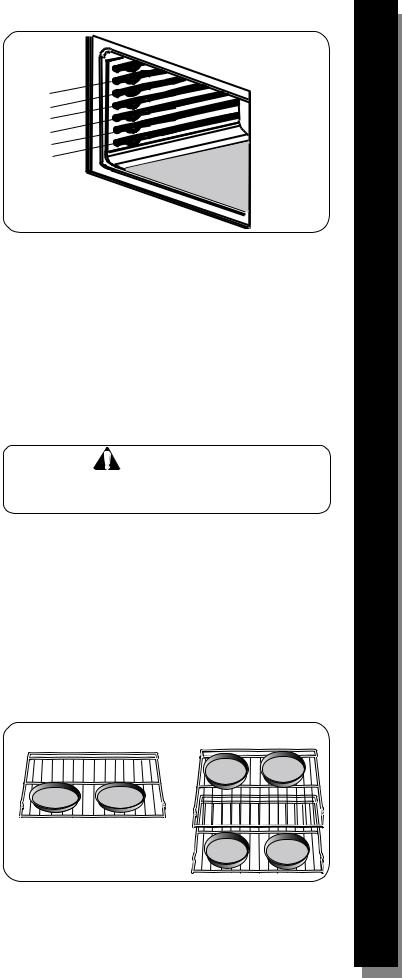
Oven Modes and Features
Rack Position
(see graphic at right for further details)
RACK 6 (highest position) – Use for melting cheese, broiling thin foods.
RACK 5 – Use for broiling most meats, toasting bread. RACK 4 – Use for broiling thicker meats.
RACK 3 – Use for most baked goods when baking on one rack, such as on a cookie sheet or baking pan, cakes, frozen convenience foods, biscuits, brownies, muffins.
RACK 2 – Used for pies, casseroles, breads, bundt or pound cakes, small roasts or poultry.
RACK 1 (lowest position) – Use for angel food cake, large roasts, turkey.
RackPosition
6
5
4
3
2
1
... Our Inspiration
Started Getting
Preheating
Preheat the oven if the recipe recommends it. Preheating is necessary for good results when baking cakes, cookies, pastry and breads. When using the probe, preheating is not recommended. Setting a higher temperature does not shorten preheat time. Place oven racks in proper position before preheating. A beep will confirm that the oven is preheated and the selected oven temperature will be displayed.
Baking Pans
Glass baking dishes absorb heat, therefore reduce oven temperature 25° F when baking in glass.
Shiny, smooth metal reflects heat resulting in lighter, more delicate browning.
Dark, rough or dull pans will absorb heat resulting in browner, crisper crust. Some manufacturers recommend reducing temperature 25° F when using this type of pan. Follow manufacturer recommendations. Use glass or dark metal pans for pies.
Insulated baking pans may increase the length of the recommended baking time.
Multiple Rack Cooking
When using multiple racks, follow the placement recommendations below.
Two rack: Use rack positions 2 and 5. The rack in position 2 can be a full extension rack if desired.
Pan Placement
Baking results are better if pans are placed on the center rack. If baking more than one pan on a rack, allow at least 1" to 1 ½” of air space around the pan. When baking four cake layers at the same time, stagger pans on two racks so that one pan is not directly above the other. See graphic at right.
Three rack: (for convection bake): Use positions 1, 3 and 6. The rack in position 3 can be a full extension rack if desired.
CAUTION:
Many factors affect cooking performance. Always check food for doneness before serving.
Multiple Rack Cooking - Pan Placement |
|
One Rack |
Two Racks |
- Use
OvenTheCooktop
Help Self Cleaning and Care
English • 13
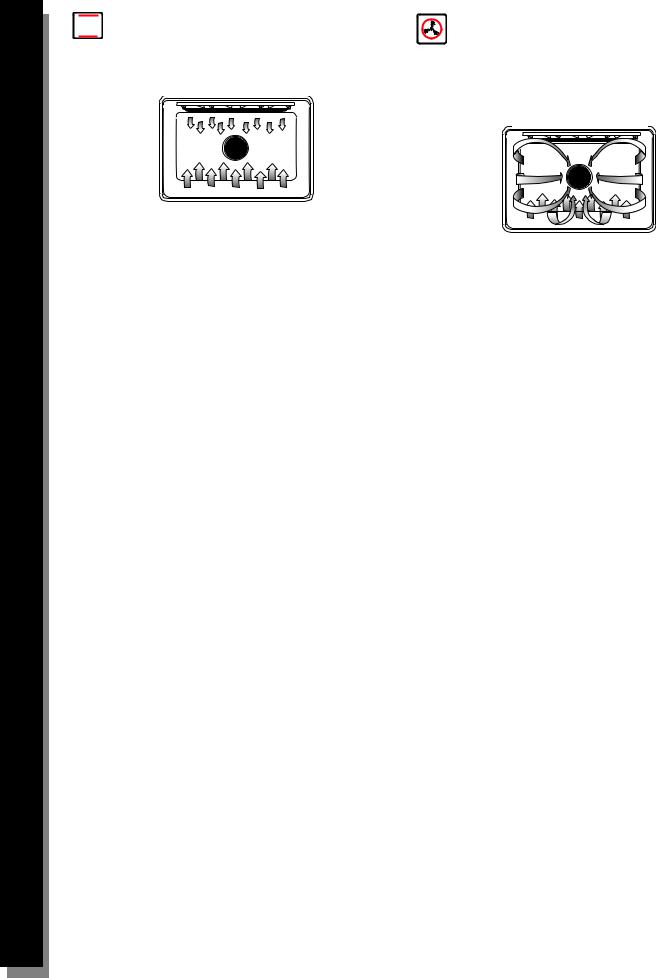
Your Life ... |
Oven Modes and Features |
Use - The CooktopOven Getting Started
Self Help Care and Cleaning
BAKE, PROOF (some models) and WARM
Baking is cooking with dry, heated air. Both the upper and lower element cycle to maintain the oven temperature:
The Bake mode can be used to prepare a variety of food items, from pastries to casseroles. It can also be used to roast meats.
In the Warming mode, the oven uses the upper and lower element to maintain a low temperature to keep food at serving temperature.
•Use the Warming setting on the oven to keep foods hot until ready to serve.
•The Warming mode temperatures are 140° - 220°F. The default temperature is 170° F.
•Foods that need to be kept moist should be covered with a lid or aluminum foil.
In the Proofing mode, the oven will use the upper and lower element to maintain a low temperature to proof bread. Proofing is the rising of a yeast dough.
•The Proofing mode temperatures are 85° to 110° F. The default temperature is 100° F.
•Loosely cover the bowl or pan and use any rack that accommodates the size of the container.
•Keep the door closed and use the oven light to check the rising of the dough.
*The convection bake temperature is 25° F less than recommended on packages or recipes. The temperature in this chart has been reduced 25° F.
**This chart is a guide. Actual times depend on the mixes or recipes baked. Follow recipe or package directions and reduce temperature appropriately.
CONVECTION BAKE
Convection Baking is similar to Baking. In this case, heat comes from the lower heating element and a third element behind the backwall. The main difference in convection baking is that the heat is circulated throughout the oven by the convection fan:
The Convection Bake mode is well-suited for baking large quantities of food on multiple racks. It can be used to prepare cookies, pies, cupcakes, pastries, breads, snack foods and appetizers among other items.
The benefits of Convection Baking include:
•Slight decrease in cooking time
•Three rack cooking
•Higher Volume (yeast items rise higher)
•Cook more items at once
For Best Results:
•Reduce recipe temperature by 25° F. Refer to the Convection Baking chart for examples.
•Place food in low-sided, uncovered pans such as cookie sheets without sides.
•Center baking pans side to side on the oven rack.
ConvectionBakeChart
|
Rack |
Temp.* |
Convection |
|
|
(preheated |
|||
Food Item |
Bake Time ** |
|||
Position |
oven) |
|||
|
(min) |
|||
|
|
(F˚) |
||
|
|
|
||
|
|
|
|
|
Cake |
|
|
|
|
Cupcakes |
3 |
325 |
17 - 19 |
|
Bundt Cake |
2 |
325 |
37 - 43 |
|
Angel Food |
1 |
325 |
35 - 39 |
|
|
|
|
|
|
Pie |
2 |
350 - 400 |
45 - 55 |
|
2 crust, fresh, 9" |
||||
2 crust, frozen fruit, 9" |
2 |
350 |
68 - 78 |
|
|
|
|
|
|
Cookies |
|
|
|
|
Sugar |
3 |
325 - 350 |
6 - 11 |
|
Chocolate Chip |
3 |
325 - 350 |
8 - 13 |
|
Brownies |
3 |
325 |
29 - 36 |
|
|
|
|
|
|
Breads |
|
|
18 - 22 |
|
Yeast bread, loaf, 9x5 |
2 |
350 |
||
Yeast rolls |
3 |
350 - 375 |
12 - 15 |
|
Quick Bread, loaf, 8x4 |
2 |
325 - 350 |
45 - 55 |
|
Biscuits |
3 |
350 - 375 |
11 - 15 |
|
Muffins |
3 |
400 |
15 - 19 |
|
|
|
|
|
|
Pizza |
|
|
|
|
Frozen |
3 |
375 - 425 |
23 - 26 |
|
Fresh |
3 |
400 - 425 |
12 - 15 |
|
|
|
|
|
14 • English
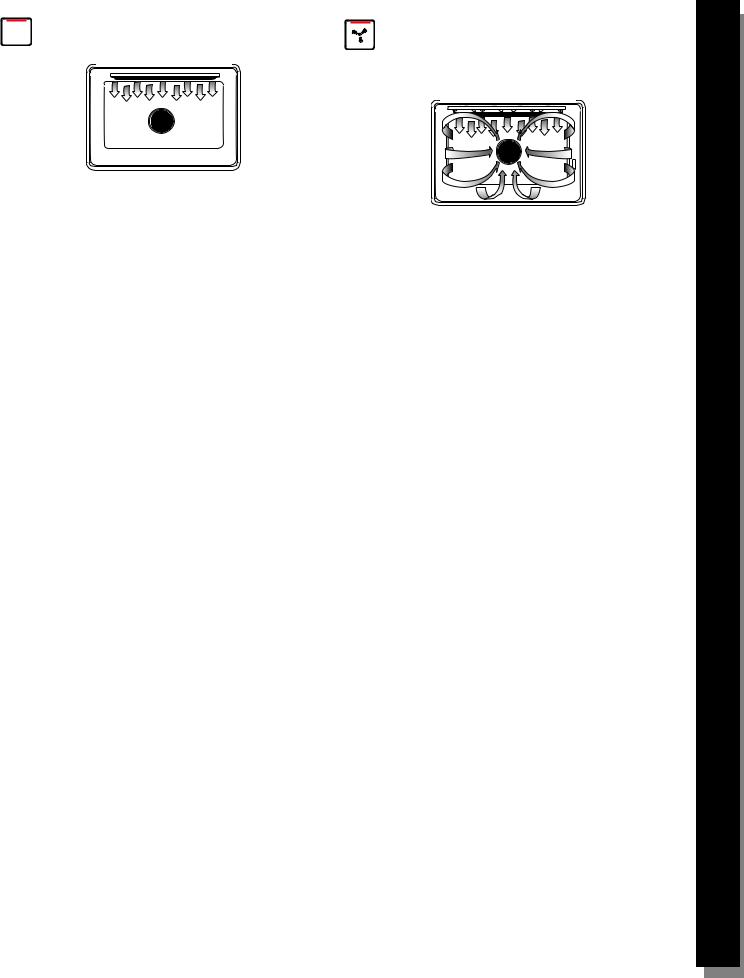
Oven Modes and Features |
... Our Inspiration |
BROIL
Broiling uses intense heat radiated from the upper element: 
The Broil mode is best suited to cooking thin, tender cuts of meat (1” or less), poultry and fish. It can also be used to brown breads and casseroles.
The benefits of Broiling include:
•Fast and efficient cooking
•Cooking without the addition of fats or liquids
•Browning as the food cooks
For Best Results:
•Preheat oven 3-4 minutes.
•Steaks and chops should be at least 3/4” thick.
•Brush fish and poultry with butter or oil to prevent sticking.
•Use the broil pan and grid included with your range.
•Do not cover the broiler grid with foil. It is designed to drain fats and oils away from the cooking surface to prevent smoking and spattering.
•Turn meats once halfway through the recommended cooking time (see Broil Chart for examples).
•When top browning casseroles, use only metal or glass ceramic dishes such as Corningware®.
•Never use heat-proof glass (Pyrex®); they cannot tolerate the high temperature.
ALWAYS BROIL WITH THE DOOR CLOSED
Broil Chart
Food and |
Rack |
Broil |
Internal |
Time |
Time |
|
Temp. |
Side 1 |
Side 2 |
||||
Thickness |
Position |
Setting |
||||
(°F) |
(min)* |
(min)* |
||||
|
|
|
||||
|
|
|
|
|
|
|
Beef |
|
|
|
|
|
|
Steak (3/4" - 1 ") |
|
|
|
|
6-7 |
|
Medium Rare |
5 |
High |
145 |
7-8 |
||
Medium |
5 |
High |
160 |
8-9 |
6-9 |
|
Well |
5 |
High |
170 |
9-11 |
7-10 |
|
Hamburgers |
|
|
|
|
|
|
(3/4" - 1") |
|
|
|
9-11 |
8-10 |
|
Well |
4 |
High |
160 |
|||
|
|
|
|
|
|
|
Poultry |
|
|
|
|
|
|
Breast (bone-in) |
4 |
Low |
170 |
18-20 |
18-19 |
|
|
|
|
|
|
|
|
Pork |
|
High |
160 |
|
|
|
Pork Chops (1") |
4 |
9-10 |
8-9 |
|||
Sausage - fresh |
3 |
High |
160 |
8-10 |
7-9 |
|
Ham Slice (1/2") |
5 |
High |
160 |
3-4 |
2-3 |
|
|
|
|
|
|
|
|
Seafood |
|
|
Cook |
6-7 |
DO |
|
Fish Filets, 1" |
4 |
Low |
until |
|||
Buttered |
|
|
opaque |
|
NOT |
|
|
|
|
& flakes |
|
TURN |
|
|
|
|
easily |
|
|
|
|
|
|
with fork |
|
|
|
|
|
|
|
|
|
|
Lamb |
|
|
|
|
|
|
Chops (1") |
|
|
|
|
|
|
Medium Rare |
5 |
High |
145 |
5-7 |
6-7 |
|
Medium |
5 |
High |
160 |
8-9 |
6-8 |
|
Well |
5 |
High |
170 |
9-11 |
8-9 |
|
|
|
|
|
|
|
|
Bread |
|
|
|
|
|
|
Garlic Bread, 1" |
5 |
High |
|
2-4 |
|
|
slices |
|
|
|
|
|
|
|
|
|
|
|
|
CONVECTION BROIL
Convection Broil is similar to Broil. It combines the intense heat from the upper element with heat circulated by the convection fan:
The Convection Broil mode is well suited for cooking thicker, tender cuts of meat, poultry and fish. Convection Broil is typically not recommended for browning breads, casseroles and other foods.
The benefits of Convection Broiling, in addition to the benefits of standard broiling, include:
•Faster cooking than standard Broiling
For Best Results:
•Preheat oven 3-4 minutes.
•Meats should be at least 1 1/2” thick.
•Turn meats once halfway through the cooking time (See Convection Broil Chart for examples).
•Use the broil pan and grid included with your range.
•Do not cover the broiler grid with foil. It is designed to drain fats and oils away from the cooking surface to prevent smoking and spattering.
•Salt after cooking.
ALWAYS CONVECTION BROIL WITH THE DOOR CLOSED
Convection Broil Chart
|
|
|
Internal |
Time |
Time |
|
Food and |
Rack |
Broil |
Side |
Side |
||
Temp. |
||||||
Thickness |
Position |
Setting |
1 |
2 |
||
(°F) |
||||||
|
|
|
(min)* |
(min)* |
||
|
|
|
|
|||
|
|
|
|
|
|
|
Beef |
|
|
|
|
|
|
Steak (1-½" or more) |
|
|
|
|
|
|
Medium Rare |
4 |
High |
145 |
8-9 |
7-8 |
|
Medium |
4 |
High |
160 |
10-11 |
9-10 |
|
Well |
4 |
High |
170 |
12-13 |
11-12 |
|
Hamburgers (more |
|
|
|
|
|
|
than 1") |
|
|
|
|
|
|
Well |
4 |
High |
160 |
9-11 |
7-9 |
|
|
|
|
|
|
|
|
Poultry |
|
|
|
|
|
|
Chicken Quarters |
4 |
High |
180 |
12-15 |
9-11 |
|
|
|
|
(thigh) |
|
|
|
|
|
|
170 |
|
|
|
|
|
|
(breast) |
|
|
|
|
|
|
|
|
|
|
Pork |
|
|
|
|
|
|
Pork Chops (1¼ " or |
4 |
High |
160 |
8-10 |
7-9 |
|
more) |
|
|
|
|
|
|
Sausage - fresh |
4 |
High |
160 |
6-7 |
4-5 |
|
|
|
|
|
|
|
*Broiling and Convection broiling times are approximate and may vary slightly. Times are based on cooking with a preheated broil element.
Note: The only heat setting for the Convection Broil setting is High.
Started Getting
- Use
OvenTheCooktop
Help Self Cleaning and Care
English • 15

Your Life ... |
Oven Modes and Features |
Use - The CooktopOven Getting Started
Self Help Care and Cleaning
CONVECTION ROAST
Convection Roast uses heat from the top and bottom elements as well as heat circulated by the convection fan:
The Convection Roast mode is well suited to preparing tender cuts of meat and poultry.
The benefits of Convection Roasting, include:
•As much as 25% faster cooking than standard Roasting/ Baking
•Rich, golden browning
For Best Results:
•Use the same temperature as indicated in the recipe.
•Check doneness early as roasting time may decrease by as much as 25%. Refer to Convection Roast Chart for examples.
•Do not cover meat or use cooking bags.
•Use the broil pan and grid provided with the range for roasting. A low-sided, uncovered pan can also be used.
•Use the probe (some models) or a meat thermometer to determine the internal temperature of the meat.
•If the meat is browned to your liking, but is not yet done, a small strip of foil can be placed over the meat to prevent overbrowning.
•Let meat stand covered with foil 10-15 minutes after removing from the oven.
Convection Roast Chart
|
Weight |
Oven |
Roasting |
Internal Temp. |
|
Meats |
Temp. |
Time* |
|||
(lb) |
(°F) |
||||
|
(°F) |
(min per lb) |
|||
|
|
|
|||
|
|
|
|
|
|
Beef |
|
|
|
|
|
Rib Roast |
4 - 6 |
325 |
25-32 |
145 (med rare) |
|
|
|
|
28-32 |
160 (medium) |
|
Rib Eye Roast, |
4 - 6 |
325 |
24-32 |
145 (med rare) |
|
(boneless) |
|
|
27-32 |
160 (medium) |
|
Rump, Eye, |
3 - 6 |
325 |
25-30 |
145 (med rare) |
|
Tip, Sirloin |
|
|
28-32 |
160 (medium) |
|
(boneless) |
|
|
|
|
|
Tenderloin |
2 - 3 |
425 |
15-25 |
145 (med rare) |
|
Roast |
|
|
|
|
|
|
|
|
|
|
|
Pork |
|
|
|
160 (medium) |
|
Loin Roast |
5 - 8 |
350 |
15-25 |
||
(boneless or |
|
|
|
|
|
bone-in) |
|
|
|
|
|
Shoulder |
3 - 6 |
350 |
20-30 |
160 (medium) |
|
|
|
|
|
|
|
Poultry |
3 - 4 |
375 |
14-20 |
180 |
|
Chicken - |
|||||
whole |
|
|
|
|
|
Turkey, |
12-15 |
325 |
10-14 |
180 |
|
unstuffed** |
|
|
|
|
|
Turkey, |
16-20 |
325 |
9-13 |
180 |
|
unstuffed** |
|
|
|
|
|
Turkey, |
21-25 |
325 |
6-10 |
180 |
|
unstuffed** |
|
|
|
|
|
Turkey Breast |
3 - 8 |
325 |
20-25 |
170 |
|
Cornish Hen |
1 - 1 ½ |
350 |
45-75 (total |
180 |
|
|
|
|
time) |
|
|
|
|
|
|
|
|
Lamb |
|
|
|
|
|
Half Leg |
3 - 4 |
325 |
30-35 |
160 (medium) |
|
|
|
|
25-30 |
170 (well) |
|
Whole Leg |
6 - 8 |
325 |
25-30 |
160 (medium) |
|
|
|
|
30-35 |
170 (well) |
|
|
|
|
|
|
*Roasting times are approximate and may vary depending on the shape of the meat. They are based on thawed meats.
**Stuffed turkey requires additional roasting time. The minimum safe temperature for stuffing in poultry is 165° F
16 • English
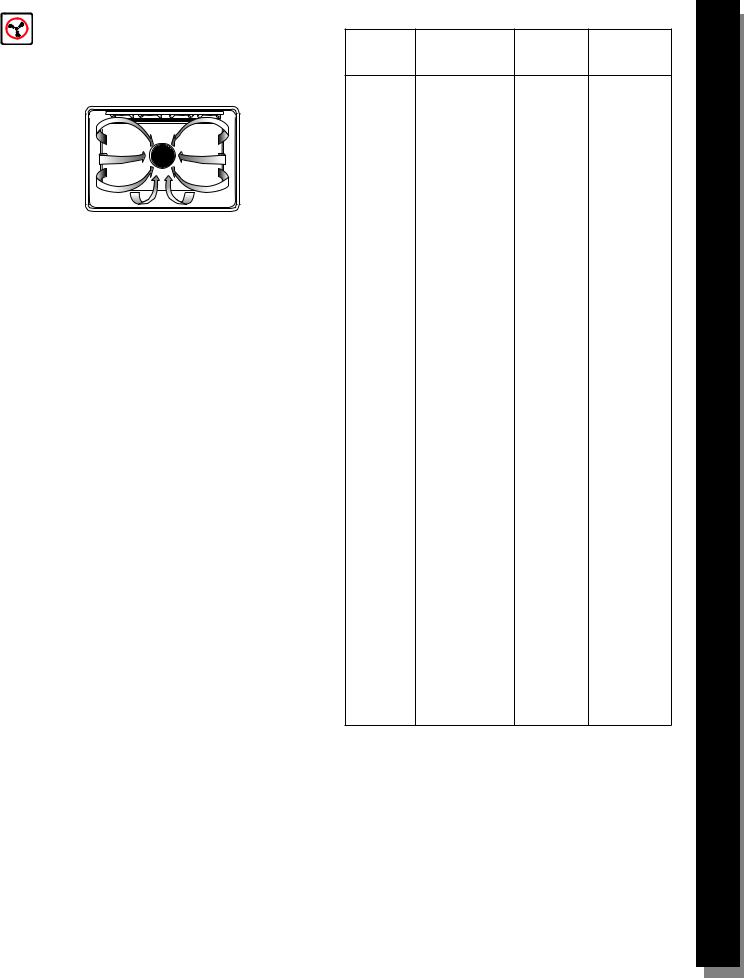
Oven Modes and Features |
... Our Inspiration |
DEHYDRATE
Dehydrate dries foods with heat from a third element behind the back wall of the oven. The heat is circulated throughout the oven by the convection fan.
Dehydrating is used to dry and/or preserve foods such as fruits, vegetables and herbs. This mode holds an optimum low temperature (100° F - 160° F) while circulating the heated air to slowly remove moisture.
For Best Results:
•Dry most fruits and vegetables at 140° F. Dry herbs at 100° F. (Refer to the Dehydrate Chart for examples).
•Drying times vary depending on the moisture and sugar content of the food, the size of the pieces, the amount being dried and the humidity in the air. Check food at the minimum drying time.
•Multiple racks can be used simultaneously. Contact your Bosch dealer for drying racks.
•Treat fruits with antioxidants to avoid discoloration.
•Consult a food preservation book, county Cooperative Extension Office or library for additional information.
The door must be open during the Dehydrate mode. Prop the door open at least 1" by placing an object (i.e.; wooden spoon) in the upper corner between the door and the side panel. Be careful that the object does not touch the oven gasket.
Dehydrate Chart
|
|
Approximate |
Test for |
|
Food |
Preparation |
Drying |
||
Doneness |
||||
|
|
Time*(hrs) |
||
|
|
|
||
|
|
|
|
Fruit |
Dipped in ¼ cup |
11-15 |
Slightly pliable |
Apples |
|||
|
lemon juice and 2 |
|
|
|
cups water; ¼" |
|
|
|
slices |
|
|
Bananas |
Dipped in ¼ cup |
11-15 |
Slightly pliable |
|
lemon juice and 2 |
|
|
|
cups water; ¼" |
|
|
|
slices |
|
|
Cherries |
Wash and towel dry. |
10-15 |
Pliable, leathery, |
|
For fresh cherries, |
|
chewy |
|
remove pits |
|
|
Orange Peels |
¼" slices of orange; |
Peels: 2-4 |
Orange peel: dry |
and slices |
orange part of skin |
|
and brittle. |
|
thinly peeled from |
Slices: 12-16 |
Orange slices: |
|
oranges |
|
skins are dry |
|
|
|
and brittle, fruit is |
|
|
|
slightly moist |
Pineapple |
Towel dried |
Canned: 9-13 |
Soft and pliable |
rings |
|||
|
|
Fresh: 8-12 |
|
Strawberries |
Wash and towel dry. |
12-17 |
Dry, brittle |
|
|||
|
Sliced ½ " thick, skin |
|
|
|
(outside) down on |
|
|
|
rack |
|
|
|
|
|
|
Vegetables |
Wash and towel dry. |
16-20 |
Leathery with no |
Peppers |
|||
|
Remove membrane |
|
moisture inside |
|
of peppers, coarsely |
|
|
|
chopped about 1" |
|
|
|
pieces |
|
|
Mushrooms |
Wash and towel dry. |
7-12 |
Tough and |
|
Cut off stem end. |
|
leathery, dry |
|
Cut into 1/8" slices |
|
|
Tomatoes |
Wash and towel dry. |
16-23 |
Dry, brick red |
|
Cut thin slices, 1/8" |
|
color |
|
thick, drain well. |
|
|
|
|
|
|
Herbs |
Rinse and dry with |
Dry at 100ºF |
Crisp and brittle |
Oregano, |
|||
sage parsley |
paper towel |
3-5 hrs |
|
and thyme, |
|
|
|
and fennel |
|
|
|
Basil |
Use basil leaves 3 |
Dry at 100ºF |
Crisp and brittle |
|
to 4 inches from top. |
3-5 hrs |
|
|
Spray with water, |
|
|
|
shake off moisture |
|
|
|
and pat dry |
|
|
Oven will stay on for 48 hours before shutting off automatically.
Started Getting
- Use
OvenTheCooktop
Help Self Cleaning and Care
English • 17
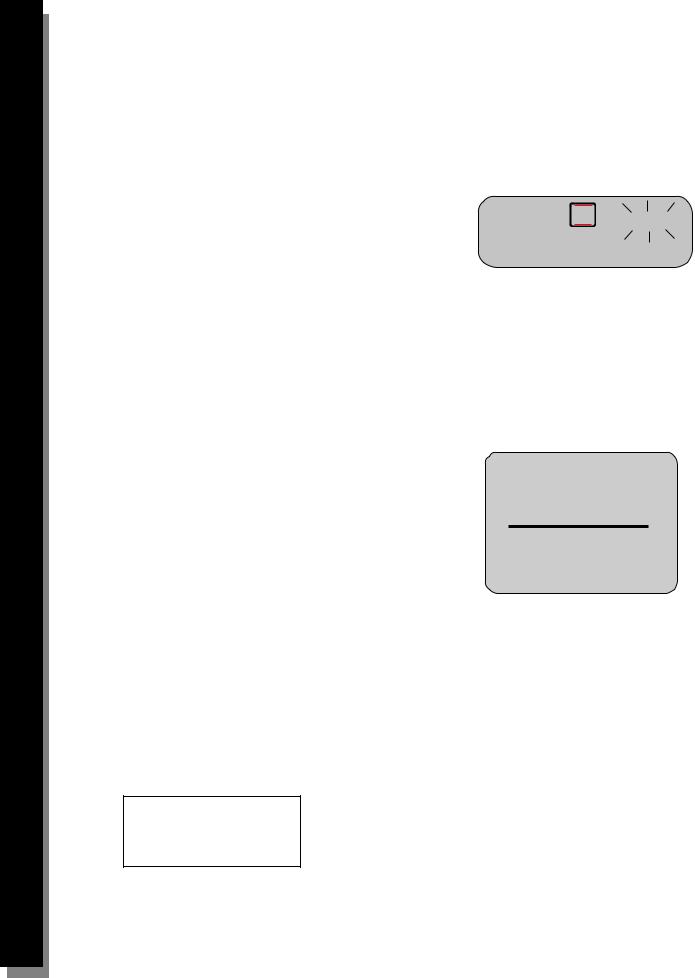
Your Life ... |
Oven Operation - Setting the Mode |
Use - The CooktopOven Getting Started
Self Help Care and Cleaning
Setting the Cooking Mode
1.TouchCOOKINGMODE.
2.BAKE will flash in the display.
If no further setting is made within 5 seconds, control will beep and flash. If this occurs, press START.
3.To change the cooking mode, turn knob.
4.PushSTART.
The selected mode will appear in the display, along with the default temperature for that mode, which will be blinking.
5.To select a different temperature, turn knob to the right or left (in 5° increments) to desired temperature.
6.Touch START. If START is not touched, oven will automatically turn on in 5 seconds.
7.The display alternates between the cooking mode and preheat.
The preheated temperature is also displayed, starting at 100° F The actual temperature increases until set temperature is reached, at which point the oven will beep.
8.To change temperature during cooking, touch
Temperature. Turn the knob to select new Temperature and press START.
9.Once cooking has been completed, touch OFF to turn off oven.
Note: After the oven has been turned off, HOT appears in the display where the cooking mode was. This is to indicate that the oven is off but still hot. When the oven temperature drops below 176° F, HOT is no longer seen in the display.
Oven Operation Time
The oven will automatically shut off after 12 hours (24 hours if the time format is set for 24 hours in the
SELECTFUNCTIONsection).
Oven Vent
The oven vent is located below the display above the rear left cooktop element.
It is normal to see steam escaping from the vent and condensation may collect on the backguard and cooktop.
 CAUTION:
CAUTION:
This area may become hot when the oven is in use.
Do not block the vent as it is important for air circulation.
6: 35PM |
380º F |
100 |
BAKE |
HELPFUL TIP
To back out of a current mode, push OFF.
Selecting OFF when not in a setting up mode will stop oven function.
18 • English
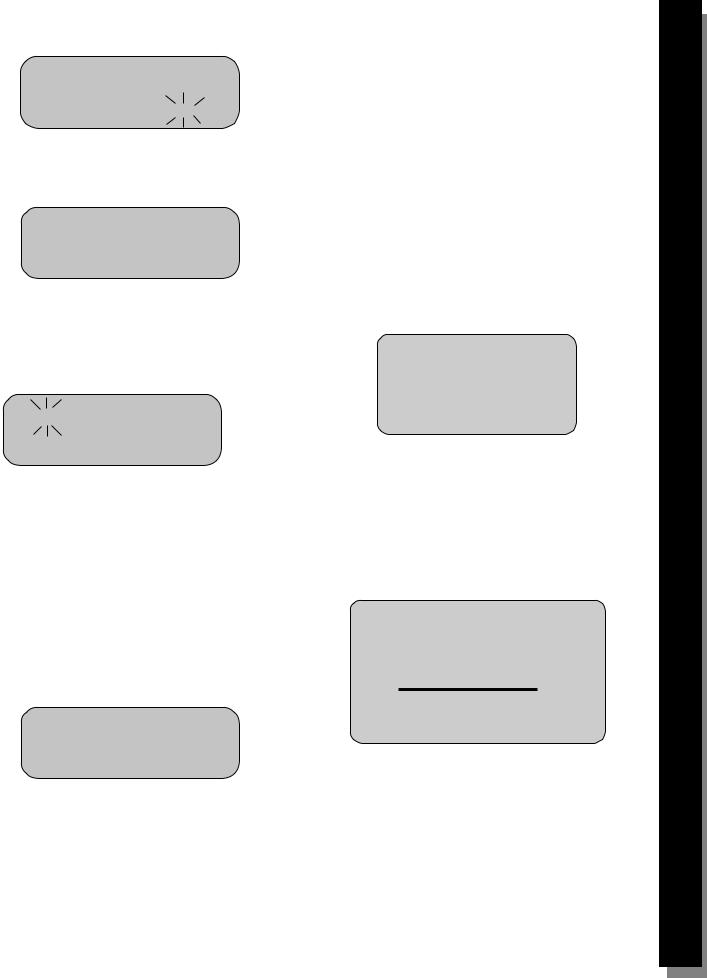
Oven Operation - Using the Timer |
... Our Inspiration |
|||
Setting the Timer/s |
Clearing the Timer/s |
|
Getting |
|
TIMER 1 |
|
display will continue flashing. |
|
|
1. Touch TIME and TIMER 1 will flash in display. |
1. |
Touch TIME once. TIMER 1 flashes. |
|
|
|
2. |
Turn knob to select CLEAR TIMER 1(2). |
|
|
0: 00 |
3. |
TouchTIME. |
|
|
4. |
If TIME pad is not touched, range will beep and |
|
||
|
|
|||
|
Touch TIME to return to the main screen. |
Started |
||
|
|
|
|
|
2. Turn clockwise and TIMER 2 will be displayed.
Select TIMER 1 or 2, then push TIME. SET TIMER 1 (2) appears in display. Minutes flash.
1: 00
HR:MIN |
SET TIMER 2 |
TIMER |
3.Turn knob to select minutes. If setting only minutes, press START. Otherwise, continue to step 4.
4.Touch TIME again and the hours will flash.
2: 02 PM
HR:MIN |
SET TIMER 2 |
|
TIMER |
||
|
5.Turn knob to the right to set hours.
6.Touch TIME again. The TIMER is now set.
7.If TIME or START is not touched, oven will begin beeping and timer display will begin flashing.
Changing the Timer/s
0: 00 AM
TIMER 1
1.TouchTime. TIMER1will appear in display. Select eitherTIMER1or2.
2.Push TIME. RESET TIMER 1 (2) appears in the display. Minute digits flash.
3.Turn knob to change minutes.
4.Touch TIME again and hour digits will flash.
5.Turn knob to change hours.
6.Touch TIME and new time is set.
TIP
Turn the knob to display the time of day or further information about the oven mode when the timers are in use.
CANCELLING
If operation is not completed, the oven will beep periodically as a reminder to set time. Push OFF to exit the TIMER mode.
Selecting OFF when not in a setting mode will stop oven function.
- Use
TheCooktopOven
Help Self Cleaning and Care
English • 19
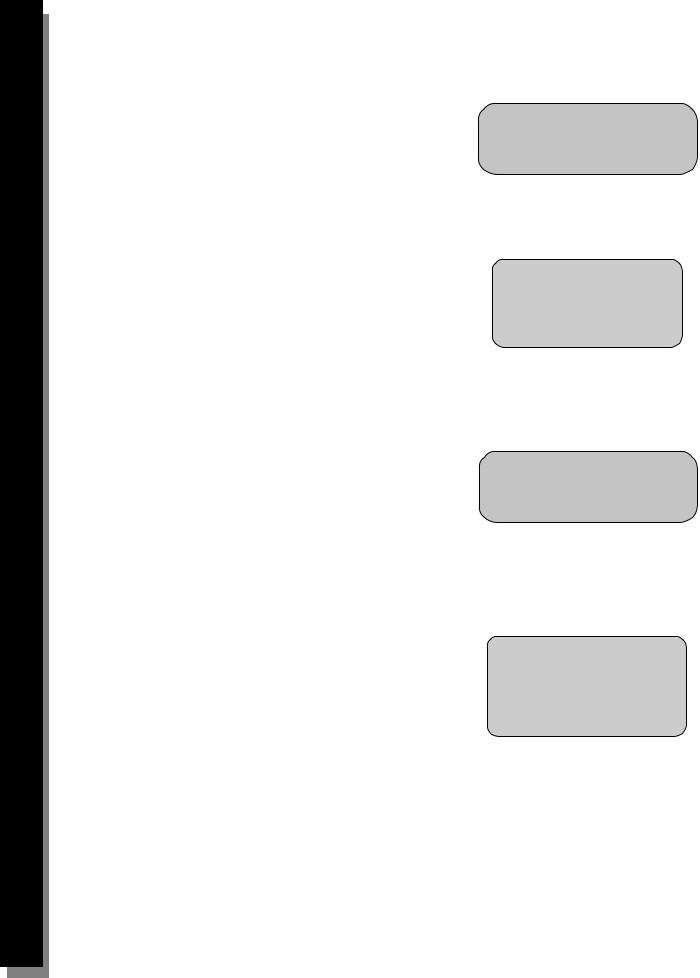
Your Life ... Oven Operation - Using Timed or Delayed Cook
Use - The CooktopOven Getting Started
Self Help Care and Cleaning
The TIMED COOK feature sets the oven to a cooking mode for a set period of time and then turns it off. The TIMED COOK feature is available for Bake, Convection Bake and Convection Roast.
Be sure that the time-of-day clock displays the correct time before beginning. See “Changing the Clock Time” to adjust the time.
Setting a Timed Mode
1.TouchCOOKINGMODE.
2.BAKE will be displayed. To select a different cooking mode, turn the knob.
3.TouchSTART.
4.Turn knob to select desired temperature.
Note: time required for the oven to reach temperature must be included in the set cooking time.
5.Touch TIME. TIMED BAKE appears in the display.
6.Touch TIME. SET BAKE TIME appears in the display and minutes flash. Set minutes. Touch TIME.
7.Hours Flash. Set hours. Touch START.
8.TIMED BAKE appears in display and the oven begins to preheat.
After cooking is complete, display flashes TIME COOK END and reminder beeps will sound. Press OFF to clear.
1: 20 |
350° F |
|
HR:MIN |
DELAYED BAKE |
|
TIMER |
||
|
NOTE
At the end of the programmed cooking time, the oven will automatically turn off.
Delaying the Start of a Timed Mode
1.Follow steps 1 through 5 above.
2.Turn knob until DELAYED BAKE appears in display.
3.Touch Time. SET BAKE TIME appears in the display and minutes flash. Set minutes. Touch TIME.
4.Hours Flash. Set hours. Touch TIME.
5.SET BAKE END appears in the display. Touch TIME.
6.Use knob to enter the time of day the oven will stop cooking or turn off.
Set hours. Touch TIME. Setminutes.Touch TIME.
The clock automatically calculates the time of day at which the cooking mode starts and stops. The displayed cooking time counts down by the minute.
7.At the end of the programmed cooking time, the oven will automatically turn off. Display will show TIME COOK END and reminder beeps will sound.
Press OFF to clear.
Note: Remove food from oven immediately after cycle has finished to prevent overcooking. Food left in the oven will continue to cook even after the cycle is complete.
To check the cooking time and stop time after a delay has been set, touch TIME. Turn knob to BAKE END orBAKETIME. TouchTIME .
5: 00 |
400° F |
|
PM |
||
HR:MIN |
DELAYED BAKE |
|
TIMER |
||
|
NOTE
Delayed cooking is not recommended for foods that need to rise (i.e.; cookies, cakes, breads, souffles, etc.)
20 • English
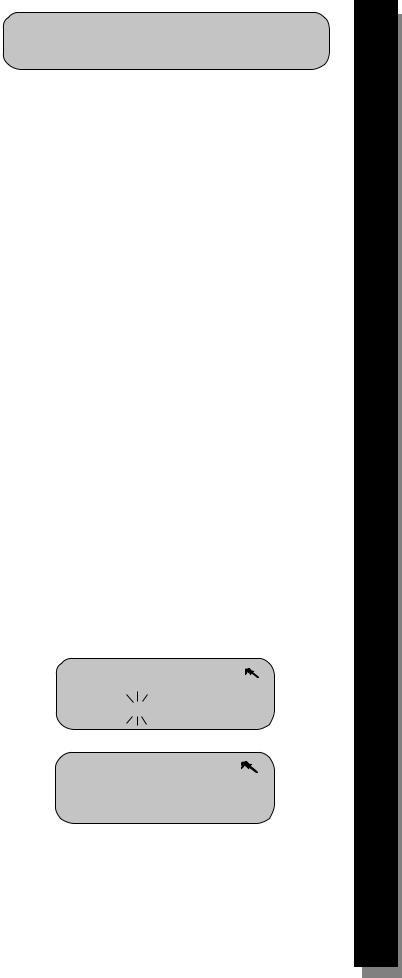
Oven Operation - Using the Probe (some models) |
... Our Inspiration |
About the Probe
•The probe can be used to determine the internal doneness or the “END” temperature of many foods, especially meats and poultry.
•The temperature range for the probe is 135°F to 200°F (57°C to 93°C).
•Preheating the oven is not recommended when using the probe. A hot oven will impair your ability to easily connect the probe to the receptacle and to insert it into the meat.
•Oven temperature can be set for 100°F up to 450°F (38°C up to 232°C).
Inserting the Probe
Insert the probe tip into the food item.
•For meats, insert the probe tip into the thickest part and do not touch bone, fat, or gristle.
•For large poultry products and turkeys, insert the probe in the thickest part of the inner thigh.
•For other foods, such as a meatloaf, the probe tip should be located in the center of the thickest part of the food.
Using the Probe
1.Prepare meat and place in roasting pan (or on rack in roasting pan as recipe specifies). Insert the probe into the meat (See “Inserting the Probe”, above).
2.Make sure the probe is not touching gristle, fat, bone, the roast rack or the pan.
3.Place roasting pan with meat in cold oven on recommended oven rack. Plug probe into the probe receptacle. The probe symbol will appear
in display.
Note: The probe temperature can only be set when the probe is installed in the oven.
4.TouchCOOKINGMODEand selectBAKE, CONVECTIONBAKEorCONVECTIONROAST.
5.Touch START. The default oven temperature will appear.
6.Turn knob to change oven temperature if necessary.
7.TouchSTART.
8.Turn knob to set the probe temperature (desired end temperature of the food.
9.TouchSTART.
•The chosen oven temperature is displayed in the upper right hand corner of the display.
•The probe temperature is displayed in the center to the left of the cooking mode. It starts at 80 degrees and increases in 5°F increments until the chosen probe temperature is reached.
•The oven is preheated when the beep signals once.
•When the set probe temperature is reached, END appears in display and oven turns off.
NOTE:
DO NOT connect to probe receptacle until probe tip is properly inserted into meat.
Probe Use Tips
•The oven is well insulated and the retained heat will continue to cook the meat after the oven has shut off. For this reason, remove the meat from the oven as soon as the control beeps.
•Since meat continues to cook after being removed from the oven, set the internal (probe) temperature 5 - 10 degrees below the desired final internal temperature (exception: poultry). Allow
“standing time” (10 -20 minutes) before carving the meat.
•Always use the handle of the probe for inserting and removing. Use a potholder to remove since the probe becomes hot.
•Remove the probe from the oven when it is not being used.
•The probe cannot be used with frozen meats. For best results, completely thaw meats before using the probe.
Changing the Oven Temperature
1.TouchTEMPERATURE. OVENTEMP will flash in the display.
2.Turn the knob to desired temperature and press START twice.
Changing the Probe Temperature
1.Touch TEMPERATURE. The oven temperature will flash.
2.Press START and PROBE TEMP will flash.
3.Turn the knob to desired temperature and press START again.
5: 00 |
PM |
325° F |
|
0 |
PROBE TEMP |
5: 00 |
PM |
325° F |
|
||
|
80 |
CONV ROASTING |
Note: Always remove probe from oven when cooking is complete. The probe symbol will remain in the display until the probe is removed. Do not leave probe attachment in oven during self-clean. Oven will not selfclean with the probe installed in the oven.
Started Getting
- Use
TheCooktopOven
Help Self Cleaning and Care
English • 21

Your Life ... |
The Warming Drawer |
Use - The CooktopWarming DrawerGetting Started
Self Help Care and Cleaning
The warming drawer will keep hot, cooked foods at serving temperature. Always start with hot food. DO NOT use to heat cold food other than crisping crackers, chips, and dry cereal, or warming dishes or plates.
Parts Key: |
1 |
2 |
|
|
1.Stainless Steel Drawer Interior
2.Gasket
3. Rail Lock |
3 |
Usable Space and Utensil Sizes
Drawer Interior: 25"W x 17"D x5" H
Utensil sizes:
•2 - 9 x 13" Pyrex 3-quart dishes, side by side.
•2 - 9 1/2 x 15" Pyrex 4-quart dishes, side by side.
•4 - 10 1/2" plates, single or stacked.
•3 - 11" plates, single or stacked.
•Large 14" pizza, in box.
The warming drawer has three settings: Low, Medium and High. The icons below are seen in the display when the corresponding setting is selected:
Low
Medium 
High
Warming Drawer Rack (some models)
Contact your dealer to order a warming drawer rack.
See the Warming Drawer Chart (next page) for recommended settings.
22 • English

The Warming Drawer |
|
... Our Inspiration |
|||||
Using Your Warming Drawer |
WarmingDrawerGuide |
|
|
|
|
|
|
|
Covered |
Getting |
|
||||
• Preheat with rack in place if using that arrangement. |
Beef, medium and well |
Med |
|
|
|||
Food should be at serving temperature (above 140° F) |
|
|
|
Covered/ |
|
|
|
before being placed in the warming drawer. |
Food |
Temperature |
|
Uncovered |
|
|
|
The warming drawer can be used with or without a |
Bacon |
Hi |
|
Uncovered |
|
|
|
rack. |
|
|
|
|
|||
|
|
|
|
|
|
|
|
It fits side to side. |
done |
|
|
|
|
Started |
|
|
|
|
|
|
|
||
Beef, rare |
Low |
|
Covered |
|
|
||
• Preheat empty serving dish while preheating drawer. |
|
|
|
||||
|
|
|
|
||||
|
|
|
|
|
|
|
|
• Add cooked, hot food in cooking utensil or in heat- |
Bread, Hard Rolls |
Med |
|
Uncovered |
|
|
|
safe serving dishes. |
|
|
|
|
|
|
|
Bread, Soft Rolls, Coffee |
Med |
|
Covered |
|
|
|
|
|
|
|
|
|
|||
• Food may be kept hot in its cooking container or |
Cakes |
|
|
|
|
||
|
|
|
|
|
|
||
|
|
|
|
|
|
|
|
transferred to a heat-safe serving dish. |
|
|
|
|
|
|
|
Biscuits |
Med |
|
Covered |
|
|
|
|
• Aluminum foil may be used to cover food. |
|
|
|
|
|
|
|
Casseroles |
Med |
|
Covered |
|
Use |
||
|
|
|
|||||
Setting the Temperature |
|
|
|
|
|
||
Eggs |
Med |
|
Covered |
|
|||
Set Temp with Oven Control |
|
|
|
|
|
||
Fish, Seafood |
Med |
|
Covered |
|
|||
Warming drawer settings are Low, Medium, and High. |
|
|
- |
||||
|
|
|
|
|
|||
|
|
|
|
|
|||
To keep several different foods hot, set the temperature |
Fried Foods |
Hi |
|
Uncovered |
|
The |
|
|
|
|
|
||||
to the food needing the highest setting. Place item |
|
|
|
|
|
|
|
Gravy, Cream Sauces |
Med |
|
Covered |
|
|
||
needing the highest setting toward the side of the |
|
|
|
|
|
|
|
|
|
|
|
|
|
||
|
|
|
|
|
|
||
drawer and item needing less heat on the rack or in the |
Ham |
Med |
|
Covered |
|
CooktopWarming |
|
• Use reversible rack, in low position to raise utensil |
|
|
|
|
|
||
center of the drawer bottom. |
Pancakes |
Hi |
|
Covered |
|
|
|
Warming Empty Serving Bowls and |
Pies, One Crust |
Med |
|
Covered |
|
|
|
Plates |
Pies, Two Crusts |
Med |
|
Uncovered |
|
|
|
• Use only heat-safe dishes. |
|
|
|
|
|||
|
|
|
|
|
|
|
|
Pizza |
Hi |
|
Covered |
|
|
|
|
|
|
|
|
|
|||
from direct contact with bottom of drawer. |
|
|
|
|
|
CareDrawer |
|
Pork |
Med |
|
Covered |
|
|||
• Warm on setting appropriate for utensil. |
|
|
|
|
|
||
Potatoes, Baked |
Hi |
|
Covered |
|
|||
• Check dish temperature during warming period. |
|
|
|||||
|
|
|
|
|
|||
Potatoes, Mashed |
Med |
|
Covered |
|
|||
• Place empty plates or dishes in a cold warming |
|
|
|||||
|
|
|
|
|
|||
drawer. Do not preheat. |
Poultry, Roasted |
Med |
|
Covered |
|
||
|
|
|
|
|
|
and |
|
Crisping Stale Items |
Vegetables |
Med |
|
Covered |
|
||
|
|
|
|
|
|||
Plates |
Low |
|
Uncovered |
|
|||
• Place food in low sided dishes or pans. |
|
|
|||||
|
|
|
|
|
|||
• Preheat on Low. |
|
|
|
|
|
Cleaning |
|
Plate of Food |
Med |
|
Covered |
|
|||
|
|
|
|
||||
• Check crispness after 45 minutes. Add time as |
|
|
|
|
|
|
|
DO NOT LINE DRAWER WITH ALUMINUM FOIL. |
|
|
|||||
needed. |
|
|
|
|
|
|
|
Preheating
• For best results, preheat warming drawer when warming food. Do not preheat when warming plates.
•Preheat times are as follows: Low: 10 minutes
Medium: 15 mintues High: 20 minutes
 CAUTION:
CAUTION:
Plastic containers or plastic wrap can melt if in direct contact with the drawer or a hot utensil. If it melts onto the drawer, it may not be removable.
Help Self
English • 23
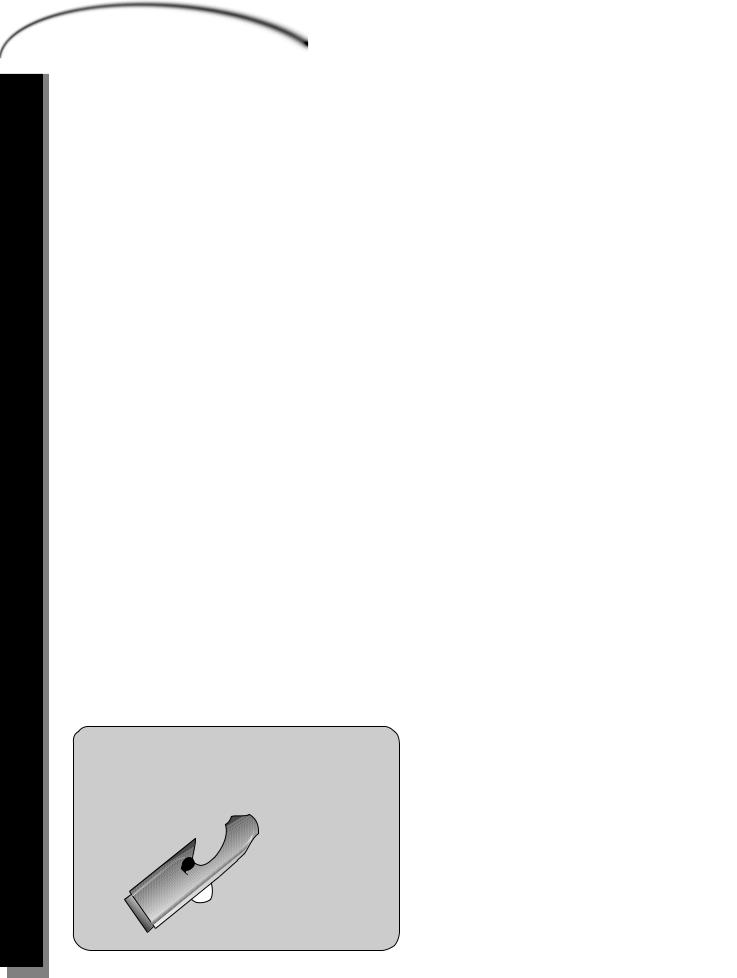
Your Life ... |
Care and Cleaning - The Cooktop |
Use - The Cooktop Getting Started
Self Help Care and Cleaning
Before Use Care
Care is easy when preventative steps are taken. For example, apply a small amount of Cooktop Cleaning Creme (packaged with range) on a daily basis.
Daily Cleaning Techniques
1.Clean the surface when it is completely cool with the Cooktop Cleaning Creme. Exception: Remove Dry Sugar, Sugar Syrup, Tomato Products and Milk immediately with the razor blade scraper (See Care and Cleaning Chart, next page).
2.Wipe off spatters with a clean, damp sponge or paper towel. Rinse and dry. Use white vinegar if smudge remains; rinse.
3.Apply a small amount of the Cooktop Cleaning
Creme. When dry, buff surface with a clean paper towel or cloth.
This provides a protective film that makes it easy to remove water spots or food spatters. The temperature of the cooking surface reduces the protective qualities of this cleaner. It must be reapplied before each use. Use a clean cloth and apply Cooktop Cleaning Creme before each use to remove dust or metal marks that can occur on the counter level surface between uses.
Cleaning the 

 Dial
Dial
Remove from cooktop. Wipe with hot, soapy cloth, rinse and dry. Do not soak or wash in dishwasher.
Using the Razor Blade Scraper
Use the scraper to remove dried or baked on foods. Hold the scraper at a 30° angle. Move it over the soil to lift it off of the cooktop. Finish with a clean, damp sponge or paper towel. Apply vinegar if smudge remains and rinse.
 Do Not Use the Following Cleaners
Do Not Use the Following Cleaners
•Glass cleaners which contain ammonia or chlorine bleach. These ingredients may permanently etch or stain the cooktop.
•Caustic Cleaners
Oven cleaners such as Easy Off® may etch the cooktop surface.
•Abrasive Cleaners
Metal scouring pads and scrub sponges such as Scotch Brite® can scratch and/ or leave metal marks.
Soap-filled scouring pads such as SOS® can scratch the surface.
Powdery cleaners containing chlorine bleach can permanently stain the cooktop.
Flammable cleaners such as lighter fluid or WD-40®.
CAUTION
Do not use any kind of cleaner on the glass while the surface is hot; use only the razor blade scraper. The resulting fumes can be hazardous to your health. Heating the cleaner can chemically attack and damage the surface.
24 • English

Care and Cleaning - The Cooktop |
... Our Inspiration |
|||||||||
Cooktop Care Chart |
|
|
|
|
|
|
|
|
||
|
|
|
|
Getting |
|
|
|
|||
|
|
|
|
|
|
|
||||
plastic film or foil. All these items REQUIRE |
|
• Remove pan and turn off the element. |
|
|
|
|
|
|||
|
|
|
|
|
||||||
TYPE OF SOIL |
|
POSSIBLE SOLUTION |
|
|
|
|
|
|
|
|
Dry sugar, sugar syrup, milk or tomato spills. Melted |
|
Failure to remove these soils immediately |
|
|
|
|
|
|
||
|
can permanently damage the surface. |
|
|
|
|
|
|
|||
IMMEDIATE REMOVAL. Remove only these types of |
|
• Wearing an oven mitt, hold scraper at 30o |
|
|
Started |
|
|
|
||
spills while the surface is hot using the razor blade |
|
Creme. |
|
|
|
|
|
|
|
|
scraper. |
|
angle, using care not to gouge or scratch |
|
|
|
|
|
|
||
Be sure to use a new, sharp razor in your scraper. |
|
the glass. Push soil off the heated area. |
|
|
|
|
|
|
||
|
• After the surface has cooled, remove the |
|
|
|
|
|
|
|||
|
|
|
|
|
|
|
|
|||
|
|
residue and apply the Cooktop Cleaning |
|
|
|
|
|
|
||
|
|
|
|
|
|
|
|
|
|
|
Burned-on food soil, dark streaks, and specks |
|
• Soften by laying a damp paper towel or |
|
|
|
|
|
|
||
|
sponge on top of soil for about 30 minutes. |
|
|
Use |
|
|
|
|||
|
|
|
|
|
|
|
||||
|
|
• Use a plastic scrubber and Cooktop Cleaning |
|
|
|
|
|
|||
|
|
|
|
|
|
|
|
|||
|
|
Creme or use the razor blade scraper. Rinse |
|
|
|
|
|
|
||
|
|
and dry. |
|
|
|
|
- |
|
|
|
|
|
|
|
|
|
|
|
|
|
|
Greasy spatters |
|
• Use a soapy sponge or cloth to remove |
|
|
The |
|
|
|
||
|
|
|
|
|
|
|
||||
|
grease; rinse thoroughly and dry. Apply |
|
|
|
|
|
|
|||
|
|
|
|
|
|
|
|
|||
|
|
Cooktop Cleaning Creme. |
|
|
|
|
Cooktop |
|
|
|
|
|
|
|
|
|
|
|
|
|
|
Metal marks: Iridescent stain |
|
• Pans with aluminum, copper or stainless |
|
|
|
|
||||
|
|
|
|
|
|
|
||||
|
steel bases may leave marks. Treat |
|
|
|
|
|
|
|||
|
|
|
|
|
|
|
|
|||
|
|
immediately, after surface has cooled, with |
|
|
|
|
|
|
||
|
|
the Cooktop Cleaning Creme. If this does |
|
|
|
|
|
|
||
|
|
not remove the metal marks, try a mild |
|
|
|
|
|
|
||
|
|
abrasive (Bon Ami®, Soft Scrub® without |
|
|
|
|
|
|
||
|
|
|
|
|
|
|
|
|||
|
|
bleach) with a dampened paper towel. |
|
|
|
|
|
|||
|
|
Rinse and reapply creme. |
|
|
|
|
|
|
|
|
|
|
Failure to remove metal marks before |
|
Care |
|
|
||||
|
|
the next heating makes removal very |
|
|
|
|||||
|
|
|
|
|
|
|
||||
|
|
difficult. |
|
|
|
|
|
|
|
|
|
|
|
|
|
|
|
|
|
|
|
Hard water spots |
|
• The minerals in some water can be |
|
and |
|
|
||||
|
transferred onto the surface and cause |
|
|
|
||||||
|
|
|
|
|
|
|||||
|
|
|
|
|
|
|
||||
|
|
stains. Use undiluted white vinegar, rinse |
|
|
|
|
|
|||
|
|
and dry. Recondition with Cooktop Cleaning |
|
Cleaning |
|
|
||||
|
|
Creme. |
|
|
|
|
|
|
||
|
|
|
|
|
|
|
|
|
|
|
|
|
|
|
|
|
|
|
|
|
|
Surface Scratches |
|
• Apply Cleaning Creme before using to |
|
|
|
|
|
|||
|
|
remove sand like grains and grit such as salt |
|
|
|
|
|
|||
|
|
and seasoning. |
|
|
|
|
|
|
|
|
|
|
• Can be reduced by using pans with bases |
|
|
|
|
|
|||
|
|
that are smooth, clean, and dry before use. |
|
|
|
|
|
|||
|
|
Use Cooktop Cleaning Creme daily on the |
|
|
|
|
|
|
||
|
|
cooktop. |
|
|
|
|
HelpSelf |
|
|
|
|
|
|
|
|
|
|
|
|
|
|
|
|
|
|
|
|
|
|
|
||
|
|
|
|
|
|
|
|
|
|
|
|
|
|
|
|
|
|
|
|
|
|
|
|
|
|
|
|
|
|
|
|
|
English • 25

Your Life ... |
Care and Cleaning - The Oven |
Use - The Cooktop Getting Started
Self Help Care and Cleaning
Self Cleaning the Oven
The Bosch Range features a self-cleaning function that eliminates the manual labor involved with cleaning your oven. During self-cleaning, the oven uses a very high temperature to burn away food soil and grease.
•It is common to see smoke and/or an occasional flame-up during the Self-Clean cycle, depending on the content and amount of soil remaining in the
oven. If a flame persists, turn off the oven and allow it to cool before opening the door to wipe up the excessive food soil.
•In a normal Self-Clean Mode, the door does not lock at the beginning of the cycle; however, it does lock prior to reaching the high self-clean
temperatures. The door lock symbol will appear in the display at this point. The door does not lock at the start of the cycle.
•The oven light does not operate during this mode.
•During Self-Clean, the kitchen should be well ventilated to help eliminate odors associated with Self-Clean. Odors will lessen with use.
•Four hours is the preset length of cleaning. The range can also be set to clean for 3 or 5 hours.
•The mode automatically stops at the end of the clean hours.
•When the oven heat returns to a safe temperature after cleaning, the automatic door lock will release and the door can be opened.
DONOT hand clean gasket
DOhand clean frame area outside gasket
DOhand clean door area outside gasket
Preparing the Oven for Self Clean
1.Remove all utensils and bakeware.
2.Remove oven racks. If oven racks are left in the oven during the self-clean cycle, they will permanently lose the shiny finish and will no longer glide smoothly on the rack guides. See Oven Cleaning Chart for proper care.
3.Wipe up any soft soil spills and grease with paper towels. Excess grease will cause flames and smoke inside the oven during self-cleaning.
4.Review illustration below. Some areas of the oven must be cleaned by hand before the cycle begins. Use a soapy sponge or plastic scrubber or a detergent-filled S.O.S.® pad. Hand-clean the oven door edge, oven front frame and up to 1-1/2 inches inside the frame with detergent and hot water. Do not clean or rub the gasket on the oven. The gasket is designed to hold in heat during the self-clean cycle. Rinse all areas thoroughly then dry.
5.Be sure oven light is turned off and the light bulbs and lens covers are in place. Do not operate oven without lightbulb and cover in place.
Caution: Do not use Commercial Oven Cleaners on the self-clean oven or any oven part. They can damage the finish or the part.
 WARNING
WARNING
A flexible door gasket is necessary for a good seal. Do not clean, rub, damage or move the gasket.
DO hand clean 1-1/2" from rack guides to front of oven cavity.
26 • English
